Physical Address
304 North Cardinal St.
Dorchester Center, MA 02124
![]() Additional content is available online at Elsevier eBooks for Practicing Clinicians
Additional content is available online at Elsevier eBooks for Practicing Clinicians
The evaluation of patients with suspected cardiac arrhythmias is highly individualized and must include a comprehensive assessment of the patient. Evaluation of the patient begins with a careful history and physical examination and should usually progress from the simplest to the most complex diagnostic test, from the least invasive and safest to the most invasive and risky, and from the least expensive out-of-hospital evaluations to those that require hospitalization and sophisticated, costly, and potentially risky procedures. However, two key features—the history and the electrocardiogram (ECG)—are pivotal in directing the diagnostic evaluation and treatment. The physical examination is focused on determining whether there is cardiopulmonary disease that is associated with specific cardiac arrhythmias. The absence of significant cardiopulmonary disease often, but not always, suggests a benign cause of a cardiac rhythm disturbance. The judicious use of noninvasive diagnostic tests is an important element in the evaluation of patients with arrhythmias, and the most important is the ECG, particularly if recorded at the time of symptoms.
An evidence-based approach to the history and physical examination for patients with suspected cardiovascular (CV) disease is presented in Chapter 13 . This chapter focuses on features most germane to the patient with cardiac rhythm disturbances. However, it is essential to understand that the general medical condition of the patient may profoundly influence the presentation of any cardiac arrhythmia. This chapter discusses the approach to and diagnostic evaluation of the patient with a suspected arrhythmia, keeping in mind that arrhythmia management has two goals: addressing the patient’s symptoms as well as whatever risks the arrhythmia poses to the individual.
Patients with cardiac arrhythmias exhibit a wide spectrum of clinical presentations, ranging from asymptomatic incidental ECG abnormalities to survival from sudden cardiac arrest (SCA). The presenting features may vary with circumstances, and arrhythmias are common in the setting of CV and medical diseases, leading to overlap of symptoms and signs. The history is key to directing the evaluation of patients. In general, the more severe the presenting symptoms, the more aggressive are the evaluation and treatment. The presence of structural heart disease and prior myocardial infarction (MI) often dictates a change in the approach to the management of syncope or a presumed cardiac arrhythmia.
In assessing a patient with a known or suspected arrhythmia, several key pieces of information should be obtained that can help determine a diagnosis or guide further diagnostic testing. The mode of onset of an episode can provide clues about the type of arrhythmia or preferred treatment option. For example, palpitations that occur in the setting of exercise, fright, or anger are often caused by catecholamine-sensitive automatic or triggered tachycardias that may respond to adrenergic blocking agents. Palpitations that occur at rest or that awaken the patient can be caused by enhanced vagal tone; an example of such an arrhythmia is atrial fibrillation (AF). Lightheadedness or syncope occurring in the setting of a tightly fitting collar or turning the head suggests carotid sinus hypersensitivity. The triggering event may help establish the presence of an inherited ion channel abnormality such as the long-QT syndrome (LQTS) (see Chapter 63 ). The mode of termination of episodes can also be helpful: palpitations that are reliably terminated by breath-holding or by Valsalva or other vagal maneuvers probably involve the atrioventricular (AV) node as an integral part of a tachycardia circuit. On occasion, focal atrial tachycardia (AT) or ventricular tachycardia (VT) can be terminated with vagal maneuvers, as can VT originating in the right ventricular outflow tract. Patients should be asked about the frequency and duration of episodes and the severity of symptoms. These features help guide how aggressively and quickly the physician needs to pursue a diagnostic or therapeutic plan (a patient with daily episodes associated with near-syncope or severe dyspnea warrants a more expeditious evaluation than does one with infrequent episodes of mild palpitations and no other symptoms). Patients should be encouraged to report their heart rate during an episode (either rapid or slow, regular or irregular) by counting the pulse directly or by using a blood pressure or heart rate monitor, wearable, or smart phone application. Devices recording an ECG waveform provide the most reliable data.
A careful drug and dietary history should also be sought; some nasal decongestants can provoke tachycardia episodes, whereas beta-adrenergic receptor-blocking eye drops for the treatment of glaucoma can drain into tear ducts, be absorbed systemically, and precipitate syncope secondary to bradycardia. Dietary supplements, particularly those containing stimulants, can cause arrhythmias. A growing list of drugs can directly or indirectly affect ventricular repolarization and produce or exacerbate long-QT interval–related tachyarrhythmias (see Chapter 9 ). The patient should be questioned about the presence of systemic illnesses that may be associated with arrhythmias, such as chronic obstructive pulmonary disease, thyrotoxicosis (see Chapter 94 ), pericarditis ( Chapter 86 ), and chronic heart failure ( Chapter 49, Chapter 50 ), as well as previous chest injury, surgery, radiation therapy, or chemotherapy.
A family history of a significant cardiac arrhythmia may not directly inform the prognosis of a patient, but it should alert the practitioner to the possibility of a heritable trait such as a channelopathy ( Chapter 63 ), cardiomyopathy ( Chapter 52, Chapter 54 ) or neuromuscular disease ( Chapter 100 ) that may increase susceptibility to development of an arrhythmia.
In the absence of symptoms, the physical examination is focused on determining whether CV or general medical disease is present. The lack of significant cardiopulmonary disease often, but not always, suggests benignity of a rhythm disturbance. Conversely, palpitations, syncope, or near-syncope in the setting of significant heart or lung disease have a more ominous prognosis. In addition, the physical examination may reveal the presence of a persistent arrhythmia such as AF. The detailed approach to the CV physical examination is outlined in Chapter 13 and may suggest the presence of structural heart disease (and thus generally a clinically more serious situation with a worse overall prognosis), even in the absence of an arrhythmia episode. For example, a laterally displaced or dyskinetic apical impulse, a regurgitant or stenotic murmur, or a third heart sound in an older adult can denote significant myocardial or valvular dysfunction or damage.
The general physical examination is also important and can identify medical conditions associated with cardiac manifestations and arrhythmias. Inspection of the skin may reveal erythema chronicum migrans, the rash associated with Lyme disease; hair loss and exophthalmos may reflect the presence of thyroid disease; and ptosis, cataracts, and skeletal muscle wasting or myotonia may indicate the presence of neuromuscular disease (see Chapter 100 ). Even facial features may suggest an associated rhythm disorder (e.g., cataracts and early balding with myotonic dystrophy, micrognathia, and low-set ears in Andersen-Tawil syndrome).
If tachycardia is present, the priorities are evaluation of the heart rate and blood pressure, and to obtain a 12-lead ECG if the patient is hemodynamically stable. If it is not possible to obtain an ECG, several clues on the physical examination can help to make a diagnosis. The presence of regular cannon A waves in the jugular venous pulse would be consistent with 1:1 retrograde ventriculoatrial activation, as in tachycardias such as atrioventricular reentrant tachycardia (AVRT), atrioventricular nodal reentrant tachycardia (AVNRT), and some junctional tachycardias and VTs. In contrast, patients may have physical examination features of AV dissociation, such as intermittent “cannon” A waves, indicative of right atrial contraction against a closed tricuspid valve, variable intensity of the first heart sound, and variable peak systolic blood pressure, consistent with arrhythmias, including VT and nonparoxysmal AV junctional tachycardia, without retrograde capture of the atria (see Chapter 13 ).
The Valsalva maneuver and carotid sinus massage (CSM) during the physical examination can be useful to interrupt arrhythmias sensitive to autonomic tone or identify the patient with a hypersensitive carotid sinus reflex. CSM is performed with the patient supine and comfortable and the head turned slightly away from the side being stimulated. The examiner first needs to listen carefully over both carotid arteries to be certain that no bruit is present. The area of the carotid sinus, at the artery’s bifurcation, is palpated lightly at the angle of the jaw until a good pulse is felt. Even this minimal amount of pressure can induce a hypersensitive response in susceptible individuals. If no initial effect is noted, a side-to-side or rotating motion of the fingers over the site is performed for up to 5 seconds. Lack of effect on the ECG after 5 seconds of pressure adequate to cause mild discomfort is considered a negative response. Because responses to carotid massage may differ on the two sides, the maneuver can be repeated on the opposite side; however, both sides should never be stimulated simultaneously. Findings may not be readily reproducible, even within minutes of a prior attempt. Gentle massage is usually sufficient to terminate a sensitive tachycardia or produce significant periods of sinus arrest or AV block in susceptible patients. The most definitive responses to CSM are tachycardia termination, as may be observed in AVRT, AVNRT, sinus node reentry, adenosine-sensitive AT, and idiopathic right ventricular outflow tract tachycardia. CSM can gradually slow a sinus tachycardia without termination and decrease the ventricular response to AT, atrial flutter, and AF without termination, allowing examination of atrial activity. CSM transiently terminates the permanent form of AV junctional reciprocating tachycardia, which then restarts when carotid massage ceases. CSM generally does not affect reentrant ventricular or junctional tachycardias ( Fig. 61.1 ). During wide-QRS tachycardias with a 1:1 relationship between the P waves and QRS complexes, vagal influence can terminate or slow a supraventricular tachycardia (SVT) that depends on the AV node for perpetuation; on the other hand, vagal effects on the AV node can transiently block retrograde conduction and thus establish the diagnosis of VT by demonstrating AV dissociation ( Fig. 61.2 ). Because the effect of either of these physical maneuvers typically lasts only seconds, clinicians must be ready to observe or record any changes in rhythm on an ECG when the maneuver is performed.

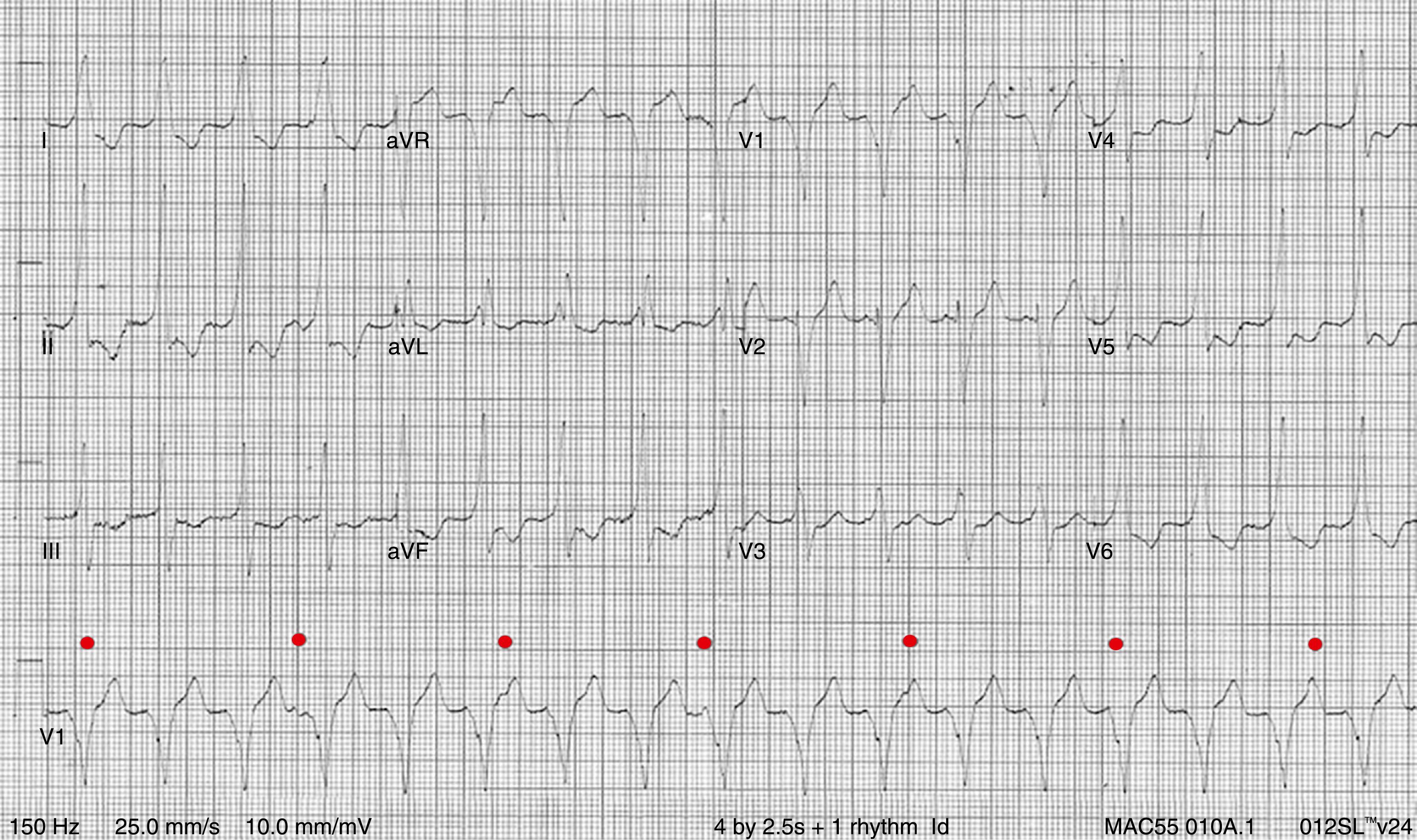
Palpitations are the awareness of the heartbeat that may be caused by a rapid heart rate, irregularities in heart rhythm, or an increase in the force of cardiac contraction, as occurs with a post–extrasystolic beat; however, this perception can also exist in the setting of a completely normal cardiac rhythm. Patients who complain of palpitations describe the sensation of an unpleasant awareness of a forceful, irregular, or rapid beating of the heart. Many patients are acutely aware of any cardiac irregularity, whereas others are oblivious, even to long runs of a rapid VT or AF with a rapid ventricular rate. The latter is particularly noteworthy because if untreated, it may be associated with stroke or may produce a tachycardia-induced cardiomyopathy. Patients may use terms such as a “pounding” or “flipping” sensation in the chest; a fullness or pounding in the throat, neck, or chest; or a pause in the heartbeat, or “skipped beat.” The skip often results from the pause after a premature ventricular complex (PVC) or the resetting of sinus rhythm after a premature atrial complex (PAC). Usually, the premature beat, particularly if it is a ventricular extrasystole, occurs too early to permit sufficient ventricular filling to cause a sensation when the ventricle contracts. The ventricular systole that ends the compensatory pause is often responsible for the actual palpitation, the result of a more forceful contraction from prolonged ventricular filling or increased motion of the heart in the chest.
Anxiety over such symptoms is usually the complaint that brings the patient to the physician’s attention. Premature atrial or ventricular complexes constitute the most common causes of palpitations. If the premature complexes are frequent, or particularly if a sustained tachycardia is present, patients are more likely to have additional symptoms, such as lightheadedness, syncope or near-syncope, chest discomfort, fatigue, or shortness of breath. The context and symptoms associated with palpitations can be diagnostically and prognostically informative. Low-risk features include isolated palpitations not induced by exercise, the absence of structural heart disease or symptoms such as syncope or chest pain, no family history of sudden cardiac death (SCD), and a normal 12-lead ECG. Associated symptoms, such as syncope or chest pain, the presence of structural heart disease or a documented arrhythmia, and family history of SCD may be associated with a more ominous cause of palpitations.
The differential diagnosis of palpitations is broad. The age of the patient and the presence of associated CV problems influence the nature of the symptoms. For example, an SVT at a rate of 180 beats/min can provoke chest pain in a patient with coronary artery disease (CAD) or syncope in a patient with aortic stenosis but may result in mild breathlessness in an otherwise healthy young person. The onset and offset of palpitations can suggest the etiology of the arrhythmia. A sudden, abrupt onset, “like a light switch turning on,” is consistent with a paroxysmal tachycardia such as AVNRT (see Chapter 65 ), whereas gradual speeding and slowing are more consistent with atrial or sinus tachycardia. However, even tachycardias that start abruptly can begin and end with extra beats appearing to have a more gradual onset and offset. Termination by Valsalva maneuver or CSM suggests a tachycardia incorporating nodal tissue in the reentrant pathway, such as sinus node reentry, AVRT, or AVNRT (see Chapter 62, Chapter 65 ).
The rate of an untreated tachycardia often narrows diagnostic possibilities, and patients should be taught to count their radial or carotid pulse rate, noting whether it is regular or irregular. Ventricular rates of 150 beats/min should always suggest the diagnosis of atrial flutter with 2:1 AV block (see Chapter 65 ), whereas most SVTs, such as those caused by AVNRT or AVRT, usually occur at rates exceeding 150 beats/min. The rates of VTs overlap with those of SVTs. Patients with bradyarrhythmias may have symptoms of low cardiac output, including fatigue, weakness, dizziness, dyspnea, and syncope (see Chapter 68 ). Palpitations can result from an increased force of contraction associated with longer ventricular filling times and may be prominent symptoms in bradycardias.
Syncope, commonly referred to as “fainting” or “passing out,” is a transient, self-limited loss of consciousness and posture resulting from a drop in blood pressure with cerebral hypoperfusion and should always prompt a search for a cause (see Chapter 71 ). It is important to distinguish syncope from other causes of transient loss of consciousness, such as seizures, metabolic disorders (hypoglycemia, hypoxia [e.g., airline decompression]), intoxication, cataplexy, and pseudosyncope. The etiologies of true syncope are varied with similarly diverse prognoses. The unheralded loss of consciousness in any patient, even if benign from the cardiac perspective, can be dangerous depending on the circumstances (e.g., while driving a vehicle, or standing at the top of a flight of stairs). However, because syncope can be a harbinger of SCD, it is important to identify cardiac from more benign causes of syncope ( eTable 61.1 ). When caused by a cardiac arrhythmia, the onset of syncope is rapid and the duration is usually brief, with or without a preceding aura, and it is not typically followed by a postictal confusional state. It can be associated with bodily injury if the patient falls while unconscious. Palpitations preceding a syncope may support an arrhythmic cause of syncope but are often absent if the loss of consciousness is rapid. Seizure activity is uncommon and occurs mostly after prolonged asystole or a rapid ventricular arrhythmia. Therefore, the seizure does not begin with or anticipate the syncope, whereas in epileptic seizures, convulsive movements start within seconds of the onset of syncope. Tongue biting or incontinence is also uncommon in cardiac syncope. In summary, syncope with early seizure activity is frequently caused by epilepsy, whereas later seizure activity is more likely caused by a cardiac arrhythmia with cerebral hypoperfusion.
| Presence of Structural Heart Disease |
|
| Clinical Features |
|
| Electrocardiographic Features |
|
| Significant Comorbidities |
|
∗ Based on European Society of Cardiology (ESC) guidelines.
† In the absence of medications with negative chronotropic effects.
‡ Suggestive of arrhythmogenic right ventricular cardiomyopathy/dysplasia.
The history of syncope should be elicited and interpreted carefully, because older people who have fallen might deny loss of consciousness during the event because of retrograde amnesia. Common arrhythmic causes of syncope include bradyarrhythmias caused by sinus node dysfunction or AV block and tachyarrhythmias, most often ventricular, but on occasion supraventricular. Bradycardia can follow tachycardia in patients with the bradycardia-tachycardia syndrome, and treatment of both may be necessary. Of the reflex syncopes—neurocardiogenic, carotid hypersensitivity, and situational—neurocardiogenic is the most common. It should be differentiated from syncope caused by orthostasis, which may be seen in autonomic failure (e.g., due to diabetes). Vasodepressor and cardioinhibitory syncope usually unfold more slowly and can be preceded by manifestations of autonomic hyperactivity such as nausea, abdominal cramping, diarrhea, sweating, or yawning. In fact, palpitations are common in this setting. On recovery, the patient may be bradycardic, pale, sweaty, and fatigued, unlike the patient recovering from a Stokes-Adams attack or an episode of VT, who may be flushed and may have a sinus tachycardia, usually without persistent mental confusion. Palpitations and presyncope on standing can be symptoms of postural orthostatic tachycardia syndrome (POTS). Drug-induced (orthostatic hypotension, bradyarrhythmia) and nonarrhythmic cardiac causes of syncope such as aortic stenosis, hypertrophic cardiomyopathy, pulmonary stenosis, pulmonary hypertension, and acute MI can be excluded by the history, physical examination, ECG, echocardiography, and other laboratory tests. Noncardiac causes of syncope, such as hypoglycemia, transient ischemic attack, and psychogenic causes, can often be excluded by a careful history (see Chapter 71 ).
SCD is common, although estimates of the incidence are confounded by inadequate case identification and secular trends that have influenced both the rates and the etiologies of sudden death (see Chapter 70 ). SCD caused by cardiac arrhythmias is most often the result of VT or ventricular fibrillation (VF); however, it can result from profound bradycardia, as might be observed in complete heart block or asystole. A variety of noncardiac conditions may be associated with life-threatening arrhythmias, including neurologic diseases (stroke, intracranial hemorrhage, epilepsy, neuromuscular disease, and Parkinson disease), diabetes, obesity, cirrhosis, anorexia, and bulimia. In well-adjudicated cases, coronary heart disease (CHD) is the most common finding in SCD and can be the first and last manifestation. Up to 80% of cases of SCD occur in patients with some form of structural heart disease, such as CHD, cardiomyopathy, or congenital heart disease. Other cardiac causes of SCD, referred to as “autopsy negative,” include primary electrical diseases such as LQTS, Brugada syndrome, catecholaminergic polymorphic ventricular tachycardia (CPVT), idiopathic ventricular fibrillation (IVF), and under some circumstances, Wolff-Parkinson-White (WPW) syndrome (see Chapter 63, Chapter 65 ). The remaining sudden deaths are usually not cardiac in etiology.
For the purposes of evaluation, SCA should be considered as SCD that someone has survived. It is essential that patients who have SCA undergo a comprehensive evaluation to identify the cause and proper treatment. A history of cardiac disease is critically important in directing the evaluation and management, as is a family history of SCD or significant cardiac arrhythmias. The circumstances at the time of SCA are often informative. Cardiac symptoms that predate the SCD suggest preexisting structural heart disease. A variety of precipitating factors can provide clues to the etiology of SCA. Exercise, emotional upset, or stress may precipitate cardiac arrest in the setting of a variety of structural heart diseases, arrhythmogenic cardiomyopathy (arrhythmogenic right ventricular cardiomyopathy/dysplasia, ARVC/D), and primary electrical diseases such as LQTS (types 1 and 2) and CPVT. SCD in LQTS3 or Brugada syndrome is more likely to occur at rest or with sleep. Fever is a common precipitant of the characteristic ECG abnormality ( Fig. 61.3 ) and arrhythmias in Brugada syndrome.
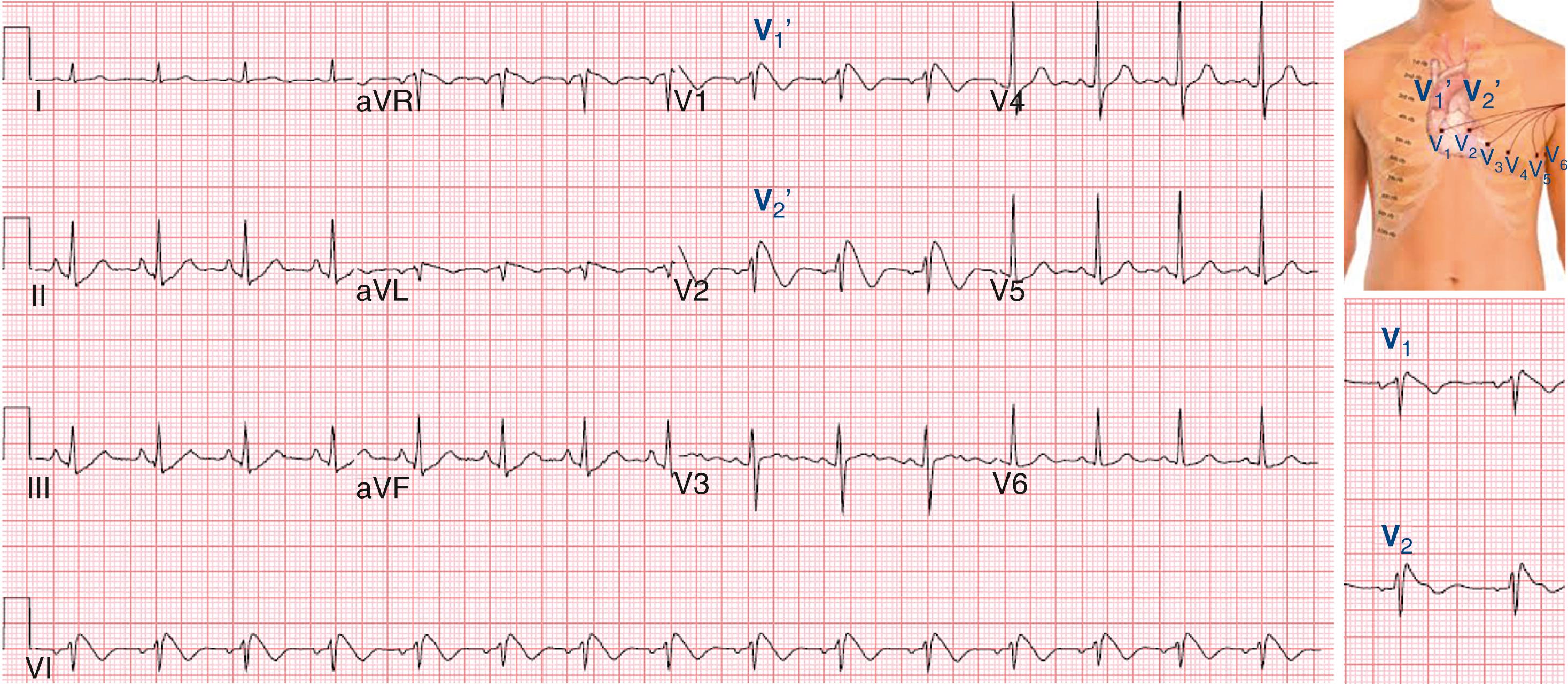
Medications and recreational drugs can increase the risk of lethal arrhythmias; patients should be asked about the use of antiarrhythmic drugs, stimulants, decongestants, psychotropics, antibiotics, alcohol, amphetamines, cocaine, and supplements, especially those used for weight loss and energy enhancement. Patients with LQTS and Brugada syndrome should be cautioned about the use of medications that may increase risk of arrhythmias. Drugs that should be avoided are listed on https://www.crediblemeds.org/and http://www.brugadadrugs.org/ , respectively. Structural heart diseases, such as dilated (DCM) or hypertrophic (HCM) cardiomyopathy (HCM SCD risk calculator https://doc2do.com/hcm/webHCM.html ) are associated with delayed ventricular repolarization, an acquired form of LQTS, and the same drugs can produce life-threatening arrhythmias in these patients.
The presence of a family history of serious ventricular arrhythmias, premature sudden death, stillbirths, sudden infant death syndrome (SIDS), unexplained motor vehicle and other accidents, and relatives with permanent pacemakers or implantable cardioverter-defibrillators (ICDs) may be relevant and will influence the evaluation of presumed heritable arrhythmias. If available, biologic materials from related decedents may be suitable for genetic testing or a molecular autopsy in suspected cases of heritable causes of SCD.
The history, physical examination, and ECG are of paramount importance in the evaluation of patients with a suspected arrhythmia. A number of other studies, alone or in combination, may assist in the diagnosis and management of patients with cardiac arrhythmias.
The judicious use of noninvasive diagnostic tests is an important element in the evaluation of patients with arrhythmias, and there is no test more important than the ECG (see Chapter 14 ). Uncommon but diagnostically important signatures of electrophysiologic disturbances may be unearthed on the resting ECG, such as delta waves in WPW syndrome, prolongation or shortening of the QT interval, right precordial ST-segment abnormalities characteristic of Brugada syndrome, and epsilon waves in ARVC/D ( Fig. 61.4 ).
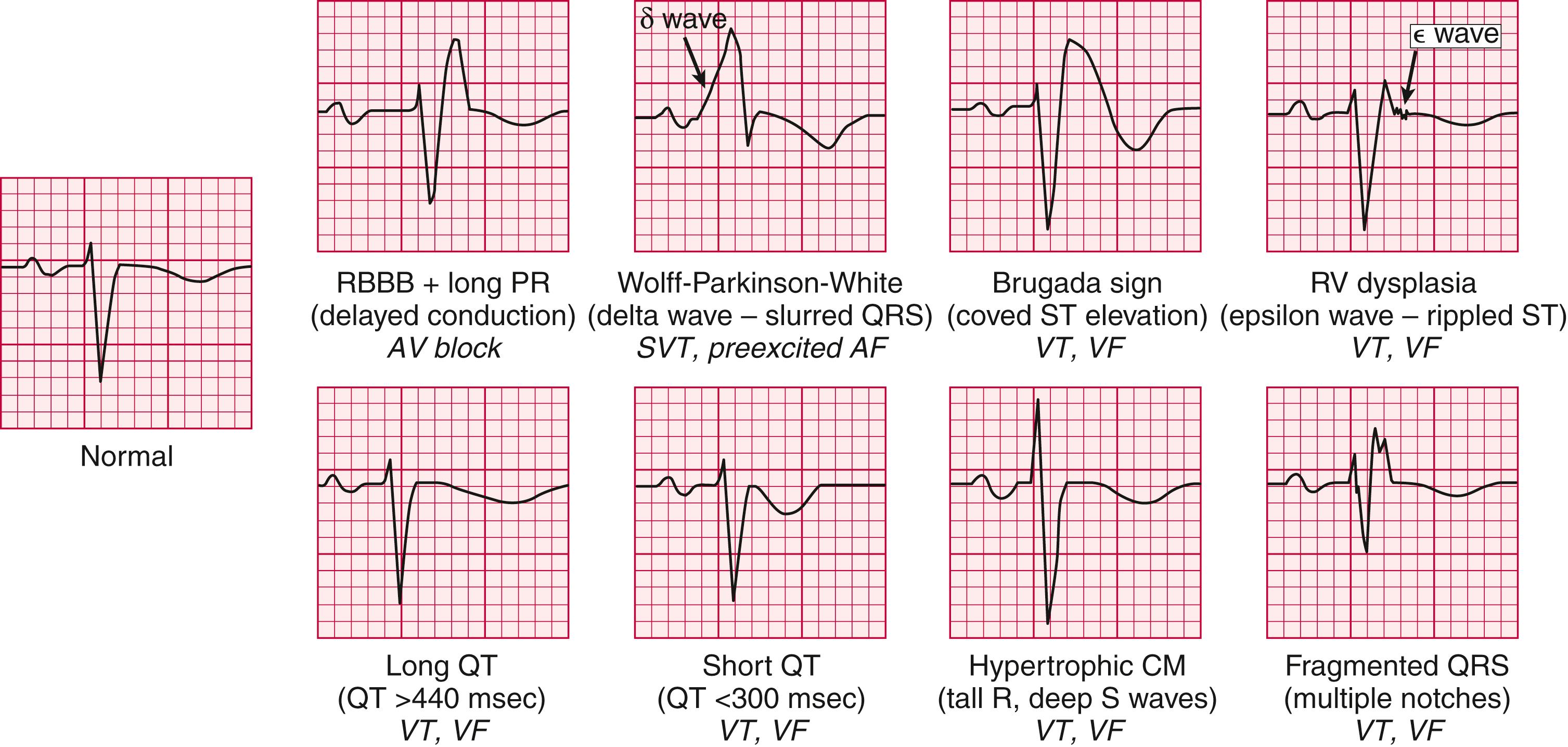
During an arrhythmia, the ECG is the primary tool for diagnosis; an electrophysiologic study (EPS), in which intracardiac electrode catheters are used to record activity from several regions of the heart at one time, is more definitive but infrequently available immediately. A 12-lead ECG in addition to a long continuous recording with the use of a lead that shows distinct P waves is often helpful for closer analysis; typically, this is one of the inferior leads (II, III, and aVF), V 1 , or aVR. The ECG obtained during an arrhythmia may be diagnostic by itself and obviate the need for further diagnostic testing.
Fig. 61.5 depicts an algorithm for the diagnosis of specific tachyarrhythmias from the 12-lead ECG (see Chapter 65, Chapter 67 ). A major branch point in the differential diagnosis concerns the QRS duration: wide-QRS (>0.12 second) tachycardias are often VTs, and narrow-QRS (≤0.12 second) tachycardias are almost always SVTs, but there is some overlap ( Table 61.1 ). Next, the most important questions to answer, regardless of QRS width, concern the characteristics of P waves. If P waves are not clearly visible on the regular ECG, atrial activity can occasionally be discerned by placing the right and left arm leads in various anterior chest positions (so-called Lewis leads), by recording atrial electrograms using intracardiac right atrial recordings (via permanent or temporary transvenous pacing leads), or by using esophageal electrodes or an echocardiogram. The last three methods are not readily available in most clinical situations and consume valuable time when dealing with a sick patient. A long rhythm strip can usually be obtained and can yield important clues by revealing P waves if perturbations occur during the arrhythmia (e.g., changes in rate, premature complexes, sudden termination, and the effect of physical maneuvers, as noted earlier). In a stable patient, if P waves are not clearly visible, the administration of adenosine by rapid intravenous bolus (6 mg followed by 12 mg if no response to the first dose) while running a rhythm strip may cause transient AV block and either terminate the tachycardia or allow discernment of P waves and diagnosis of the arrhythmia ( Fig. 61.6 ).
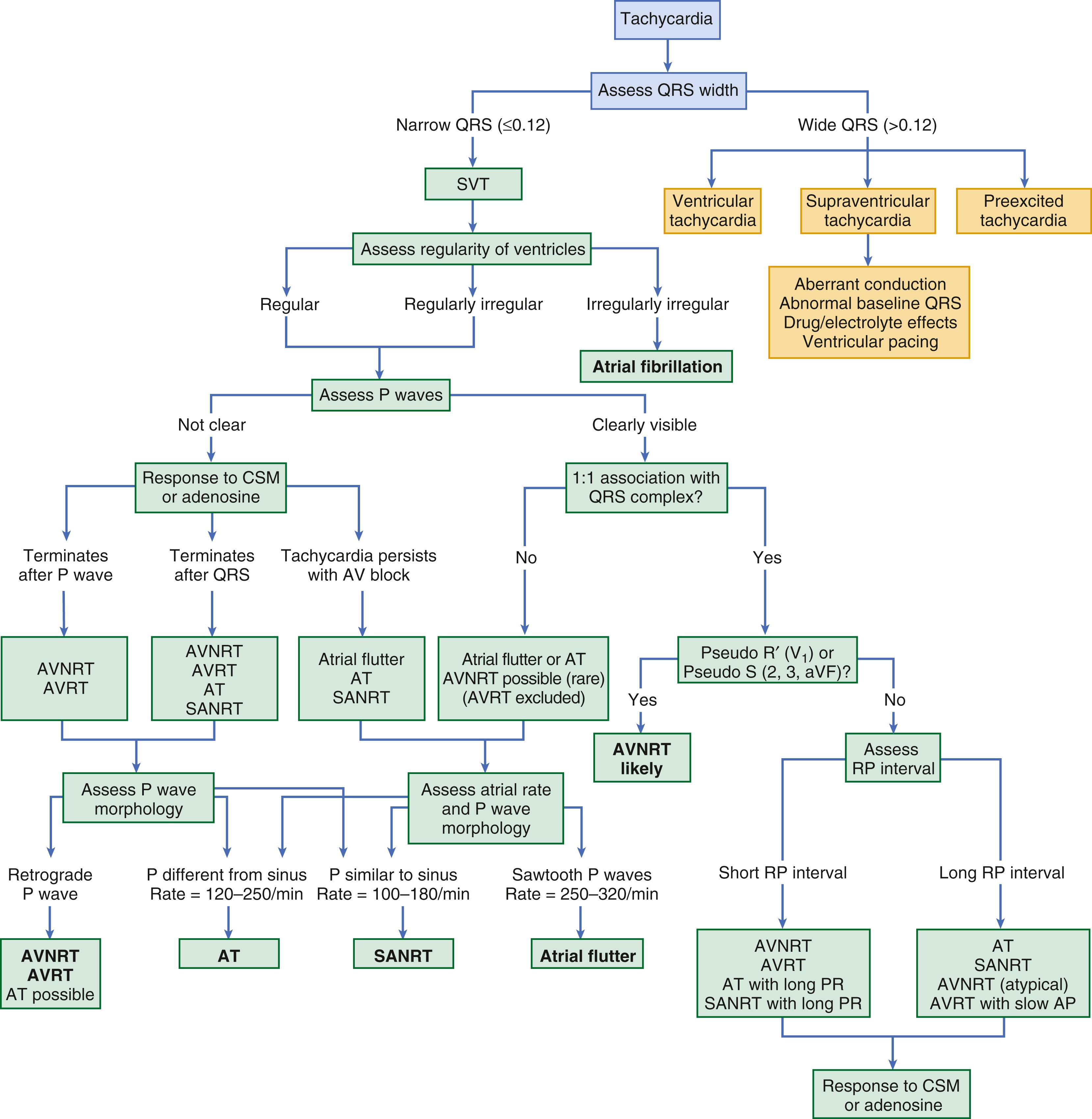
| Favor Supraventricular Tachycardia | Favor Ventricular Tachycardia |
|---|---|
| Initiation with a premature P wave | Initiation with a premature QRS complex |
| Tachycardia complexes identical to those in resting rhythm | Tachycardia beats identical to PVCs during sinus rhythm |
| “Long-short” sequence preceding initiation | “Short-long” sequence preceding initiation |
| Changes in the P-P interval preceding changes in the R-R interval | Changes in the R-R interval preceding changes in the P-P interval |
| QRS contours consistent with aberrant conduction (V 1 , V 6 ) | QRS contours inconsistent with aberrant conduction (V 1 , V 6 ) |
| Slowing or termination with vagal maneuvers | AV dissociation or other non-1:1 AV relationship |
| Onset of the QRS to its peak (positive or negative) <50 msec | Onset of the QRS to its peak (positive or negative) ≥50 msec |
| Fusion beats, capture beats | |
| QRS duration ≤0.14 sec | QRS duration >0.14 sec |
| Normal QRS axis (0–+90 degrees) | Left-axis deviation (especially −90–180 degrees) |
| Concordant R-wave progression pattern | |
| Contralateral bundle branch block pattern from the resting rhythm | |
| Initial R, q, or r >40 msec or notched Q in aVR | |
| Absence of an “rS” complex in any precordial lead |
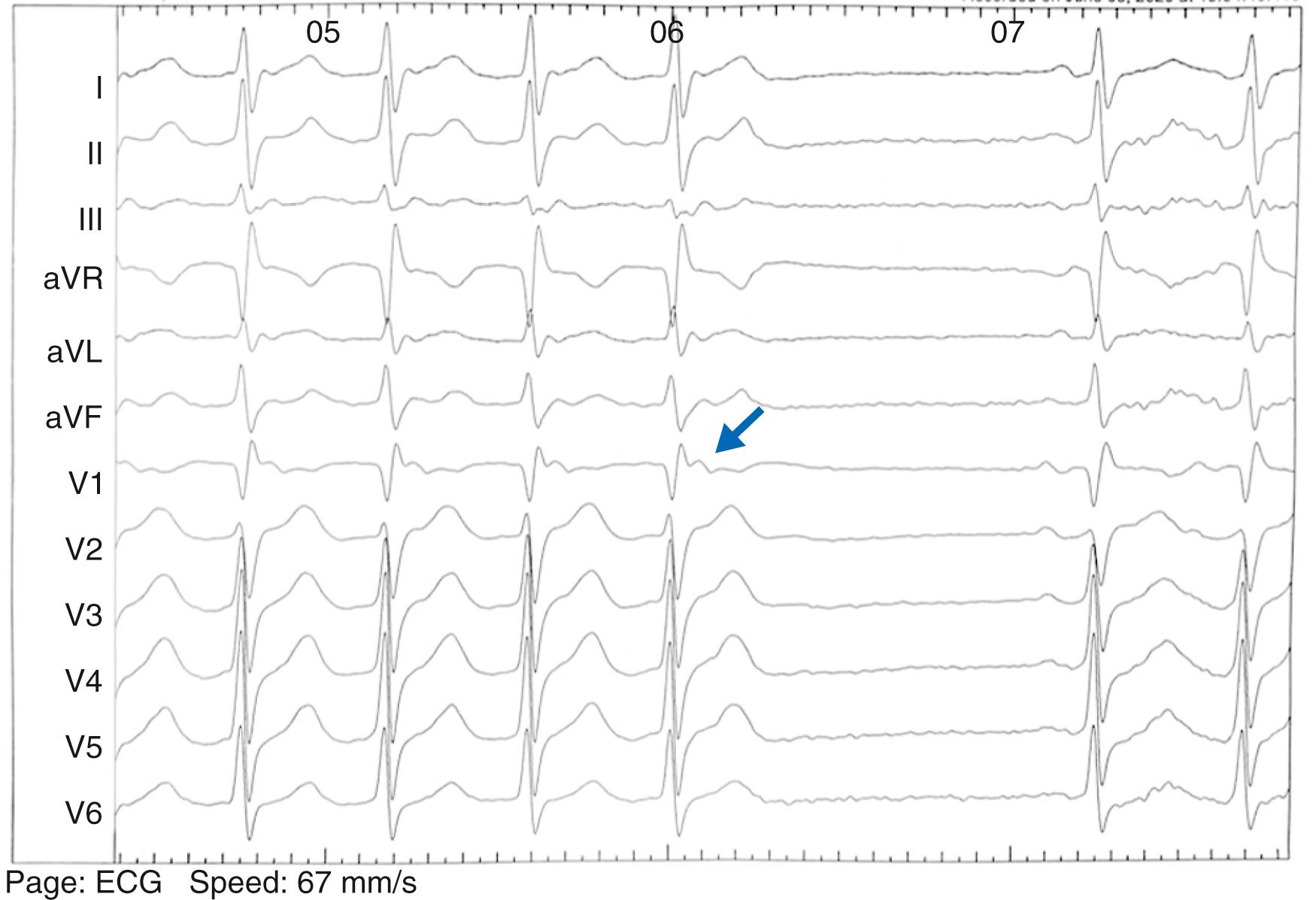
Each arrhythmia should be approached in a systematic manner to answer several key questions; as suggested earlier, many of these questions relate to P wave characteristics and underscore the importance of assessing the ECG carefully for them. If P waves are visible, are the atrial and ventricular rates identical? Are the P-P and R-R intervals regular or irregular? If irregular, is it a consistent, repeating irregularity? Is there a P wave related to each QRS complex? Does the P wave seem to precede (long RP interval) or follow (short RP interval) the QRS complex ( Fig. 61.7 )? Are the resultant RP and PR intervals constant? Are all P waves and QRS complexes identical? Is the P wave vector normal or abnormal? Are P, PR, QRS, and QT durations normal? Once these questions have been addressed, the clinician needs to assess the significance of the arrhythmia in view of the clinical setting. Should it be treated, and if so, how? For SVTs with a normal QRS complex, a branching decision tree such as that shown in Fig. 61.5 may be useful.
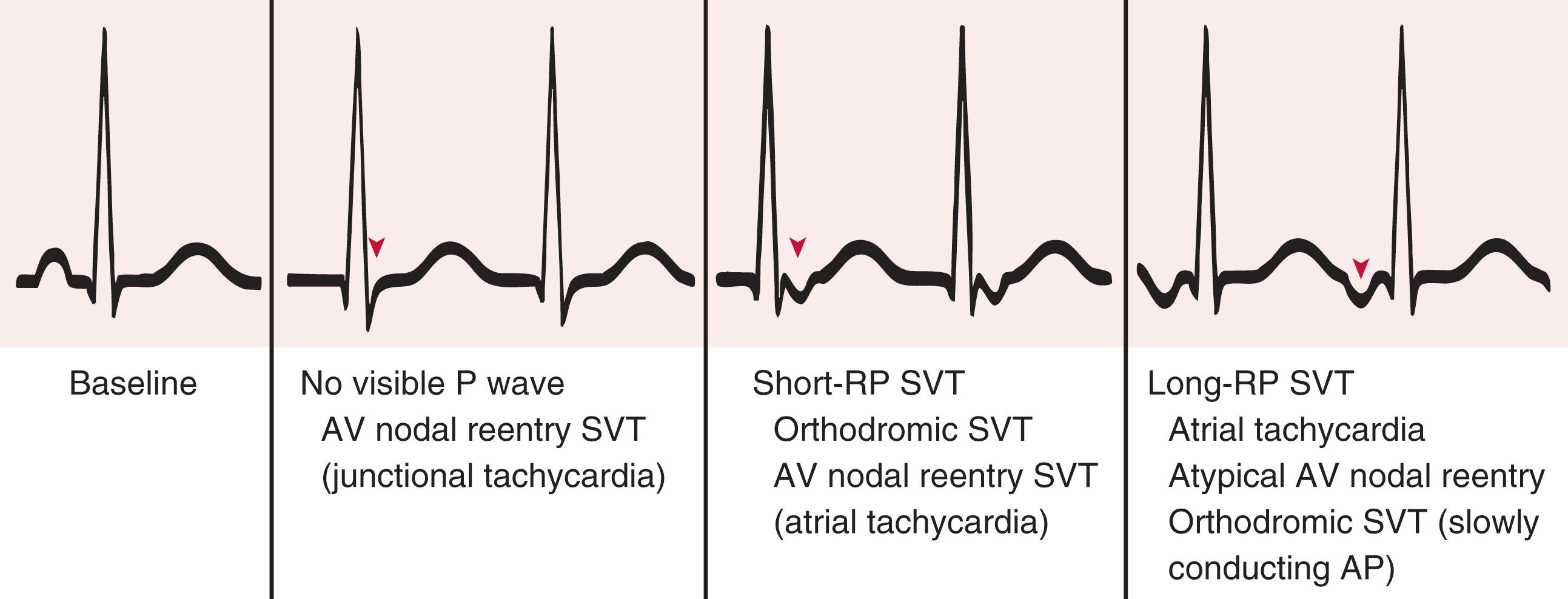
The Ladder Diagram: A ladder diagram, derived from the ECG, is used to depict depolarization and conduction schematically to aid in understanding the rhythm ( Fig. 61.8 ). Because the ECG and therefore the ladder diagram represent electrical activity as a function of time along the x-axis, conduction is indicated by the lines of the ladder diagram sloping in a left-to-right direction. Activity originating in an ectopic site such as the ventricle is indicated by lines emanating from that tier. Sinus nodal discharge and conduction and, under certain circumstances, AV junctional discharge and conduction can only be inferred; their activity is not directly recorded on the ECG.
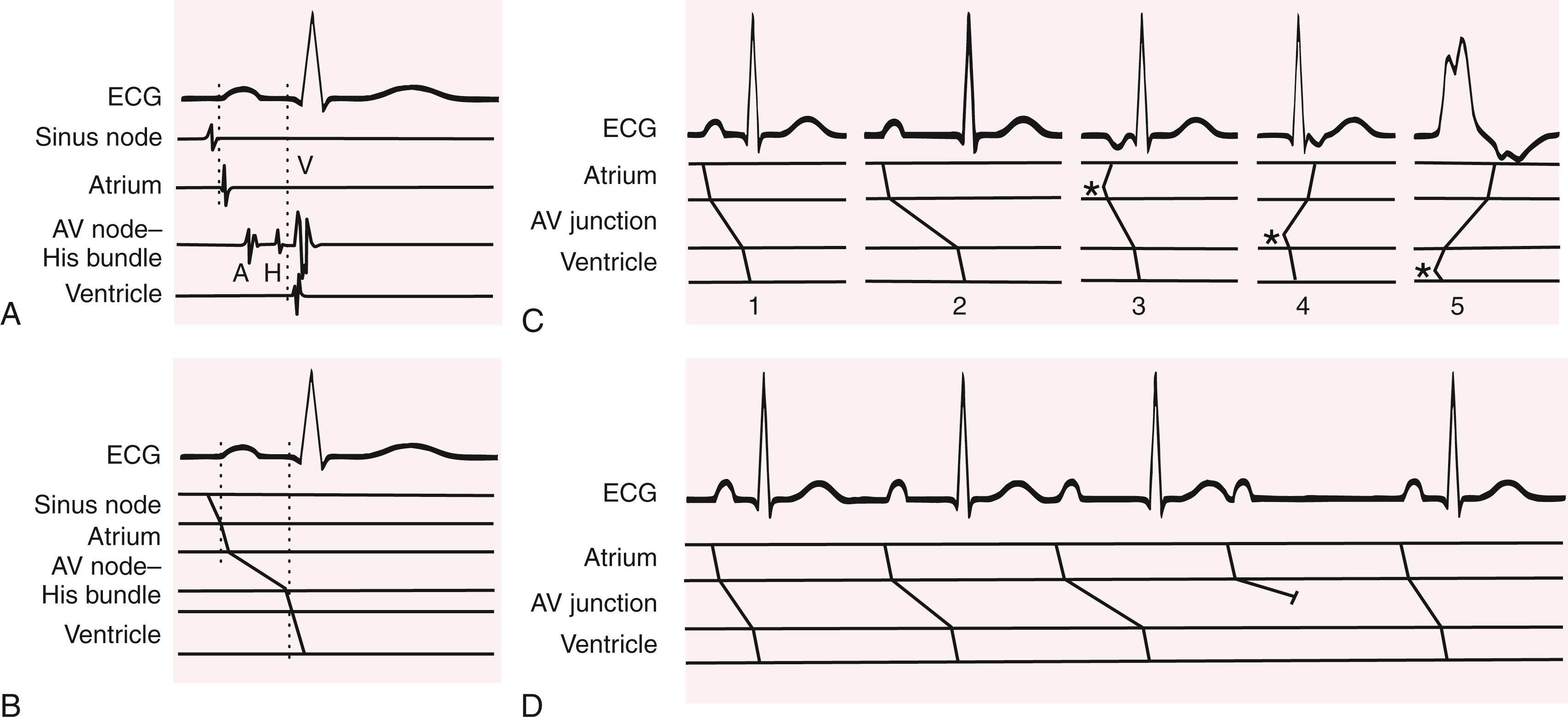
The prognostic implications of a cardiac arrhythmia depend on context, most importantly the presence of structural heart disease. The presence of structural heart disease may be apparent from the history and physical examination, chest radiograph, and ECG itself. Cardiac imaging plays an important role in the detection and characterization of myocardial structural abnormalities that can render the heart more susceptible to arrhythmias. Ventricular tachyarrhythmias, for instance, occur more frequently in patients with ventricular systolic dysfunction and chamber dilation, in HCM, and in the setting of infiltrative diseases such as sarcoidosis. Supraventricular arrhythmias may be associated with particular congenital conditions, including AV reentry in the setting of Ebstein anomaly (see Chapter 82 ). Echocardiography ( Chapter 16 ) is frequently employed to screen for disorders of cardiac structure and function. Increasingly, magnetic resonance imaging (MRI) of the myocardium ( Chapter 19 ) is being used to screen for scar burden, fibrofatty infiltration of the myocardium as seen in ARVC, and other structural changes that affect arrhythmia susceptibility. Both contrast-enhanced MRI and 18F-fluorodeoxyglucose positron emission tomography with computed tomographic transmission (18F-FDG PET/CT) have been used in the diagnosis, management, and response to treatment of cardiac sarcoidosis ( Fig. 61.9 ) (see Chapter 18 ).

Exercise electrocardiographic stress testing may be particularly useful in the evaluation of patients who experience symptoms with exertion ( Chapter 15 ). Exercise stress testing is important in determining the presence of myocardial demand ischemia and other arrhythmic substrates, such as alterations in repolarization and the dynamic behavior of the QT interval (see Chapter 63 ). Microscopic alterations in the T wave (T wave alternans, see below) at low heart rates may identify patients at risk for ventricular arrhythmias. Altered heart rate recovery may indicate autonomic dysfunction associated with heightened arrhythmic risk. A persistent elevation in heart rate after the end of exercise (delay in return to baseline) is associated with a worse CV prognosis, as is a rapid resting heart rate.
It is important to recognize that not all arrhythmias induced by exercise have an ominous prognosis. Approximately one third of individuals without heart disease will have ventricular ectopy associated with exercise. Typically, this manifests as occasional uniform PVCs, more likely to occur at faster heart rates, and not reproducible from one test to the next. Three to six beats of nonsustained VT can occur in normal subjects, especially elderly persons, and its occurrence neither implicates ischemia or other forms of heart disease nor predicts increased CV morbidity or mortality. However, multiform PVCs and VT are an infrequent response to exercise in healthy individuals; thus, the development of more complex ventricular arrhythmias during exercise testing should prompt a search for underlying structural heart disease. , Ventricular ectopy occurs in about half of patients with CAD, generally appearing more reproducibly and at lower heart rates (<130 beats/min) than in healthy individuals and often in the early recovery period. Frequent PVCs (>10 per minute), polymorphic PVCs, and VT are more likely to occur in patients with CAD. PVCs at rest can be suppressed by exercise in patients with CAD; therefore, this observation does not necessarily imply a benign prognosis or absence of underlying structural heart disease.
Patients who have symptoms consistent with an arrhythmia induced by exercise (e.g., syncope, sustained palpitations) should be considered for stress testing. Stress testing may be indicated to provoke supraventricular and ventricular arrhythmias, to determine the relationship of the arrhythmia to activity, to aid in choosing antiarrhythmic therapy and uncovering proarrhythmic responses, and to provide some insight into the mechanism of the tachycardia.
Exercise testing has diagnostic or prognostic value in patients with primary electrical abnormalities such as LQTS, CPVT, and Brugada syndrome (see Chapter 63 ). Since the QT interval can be normal in up to one quarter of patients with genetically proven LQTS, exercise testing can stress repolarizing reserves and can be useful to expose ECG abnormalities in these patients. An abnormal response of the QT interval to the heart rate acceleration produced by standing is seen in patients with LQTS compared with normal patients. Exercise testing can unmask polymorphic PVCs and VT in patients with CPVT ( Fig. 61.10 ). In patients with Brugada syndrome, significant ST-segment elevation with coving of the ST segment during the recovery phase predicts arrhythmic events during follow-up.
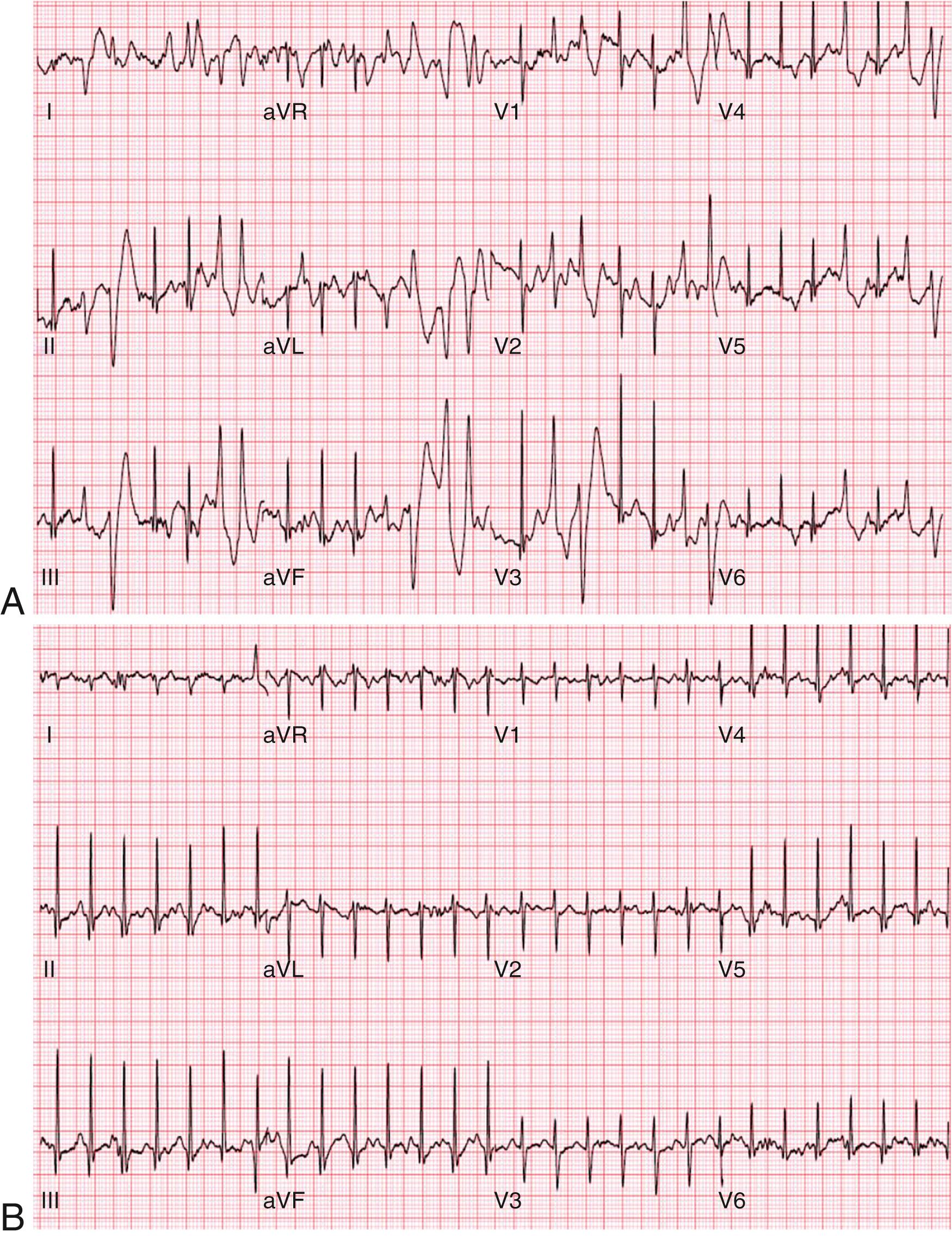
The fundamental diagnostic principle in managing patients with an undocumented cardiac rhythm disturbance is to record the ECG during a symptomatic episode and establish a causal relation between the arrhythmia and symptoms. As importantly, recording normal sinus rhythm during a patient’s typical symptomatic episode effectively excludes cardiac arrhythmia as a cause. In patients not suspected of having a life-threatening arrhythmia, Holter monitoring and event recording, continuously or intermittently, record the ECG over longer periods, enhancing the possibility of observing the cardiac rhythm during symptoms ( eTable 61.2 ). The type and duration of ECG monitoring depend on the frequency of symptoms. Most continuous recording systems are equipped with patient-triggered recording to enable correlation of the ECG with symptoms. Continuous recording systems do not require patient recognition of an arrhythmia but some do allow for patient-activated ECG data transmission.
| Device Name | Benefits | Reported Performance and Limitations |
|---|---|---|
| Zio Patch | Up to 14 days’ operation without battery replacement or recharge | Higher yield than Holter monitors (overall diagnostic yield of 63.2%); two versions available, one with real-time analysis and transmission |
| NUVANT MCT | Real-time analysis and transmission | Real-time information is not available to the user |
| RhythmStar (Rhythmedix) | 3-in-1 operation, with available real-time analysis and transmission | Holter, event, and mobile telemetry modes |
| Apple Watch | Small, lightweight, easy to operate | Sensitivity of 87% and specificity 97% in identifying patients with silent atrial fibrillation |
| Pulse-Smart | Uses standard smartphone camera and flashlight real-time analysts | Irregular pulse identification with sensitivity, specificity, and accuracy of 0.970, 0.935, and 0.951, respectively; PAC and PVC discrimination with 95.5% and 96% accuracy, respectively |
| Kardia Mobile | AF detection in 30 sec | 100% diagnostic yield compared with 72.7% with ELR |
| ECG Check | Single-lead ECG, real-time analysis and transmission | Ventricular escape beat detection sensitivity of 93.91% and predictability of 94.12% |
| cvrPhone | Cardiorespiratory event detection from ECG signals | Ischemia detection within 2 min of occlusion; apnea detection within 7.9 ± 1.1 s |
ECG monitoring systems are used in increasing proportions of inpatients regardless of history or suspicion of arrhythmias. These systems can provide valuable information about rhythm abnormalities, including mode of onset and termination, and allow prompt acquisition of a full 12-lead ECG for more detail. Telemetry can disclose intermittent heart block in a patient with presyncope that may warrant consideration of pacemaker implantation or reveal nonsustained VT in a patient with previous MI and left ventricular dysfunction and prompt an EPS for further assessment of risk. Although telemetry is helpful in many cases, it can be misleading: artifacts can simulate VT or VF, heart block, or asystole. Careful scrutiny is necessary to avoid unnecessary tests and procedures in patients with these artefactual arrhythmias ( Fig. 61.11 ).
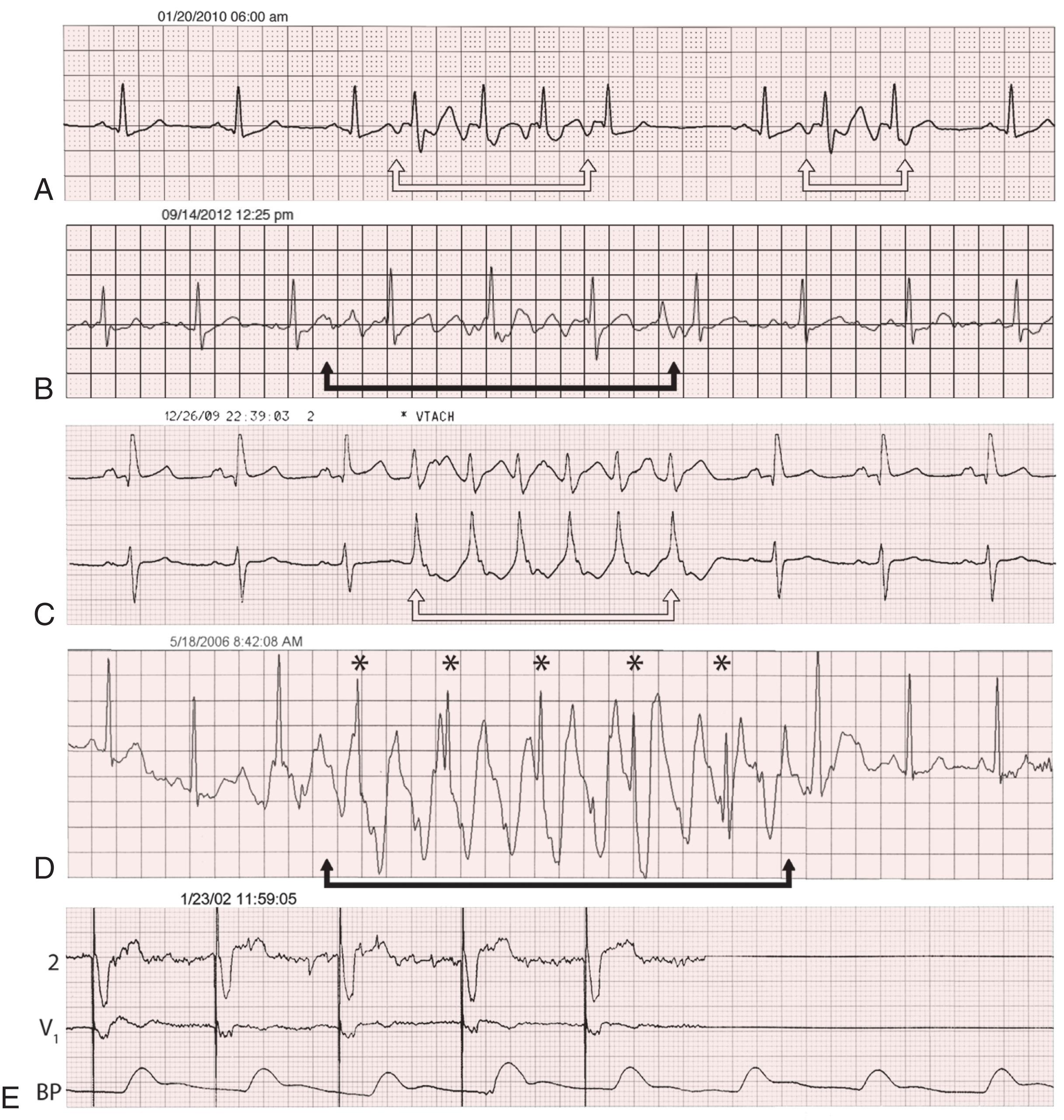
Continuous electrocardiographic recorders include the traditional Holter monitor and digitally record three or more electrocardiographic channels for 24 to 48 hours. Computers scan the recording, with human oversight, to provide a report with snapshot recordings of symptomatic events and other important findings such as asymptomatic arrhythmias or ST-segment changes. Holter monitoring is most useful in patients with frequent (daily or more often) symptoms. From 25% to 50% of patients experience a symptom during a 24-hour recording; in 2% to 15% the complaint is caused by an arrhythmia ( Fig. 61.12 ). The ability to correlate symptoms temporally with abnormalities on the ECG is one of the strengths of this technique. Guidelines for the use of ambulatory electrocardiographic recording for diagnosis, risk assessment, efficacy of antiarrhythmic drug therapy, assessment of cardiac rhythm device management, and monitoring for myocardial ischemia is summarized in the Guidelines section of the online chapter ![]() and eTable 61G.1 through eTable 61G.3 . This section addresses the requirement for maintenance of clinical competence in ambulatory electrocardiography.
and eTable 61G.1 through eTable 61G.3 . This section addresses the requirement for maintenance of clinical competence in ambulatory electrocardiography.
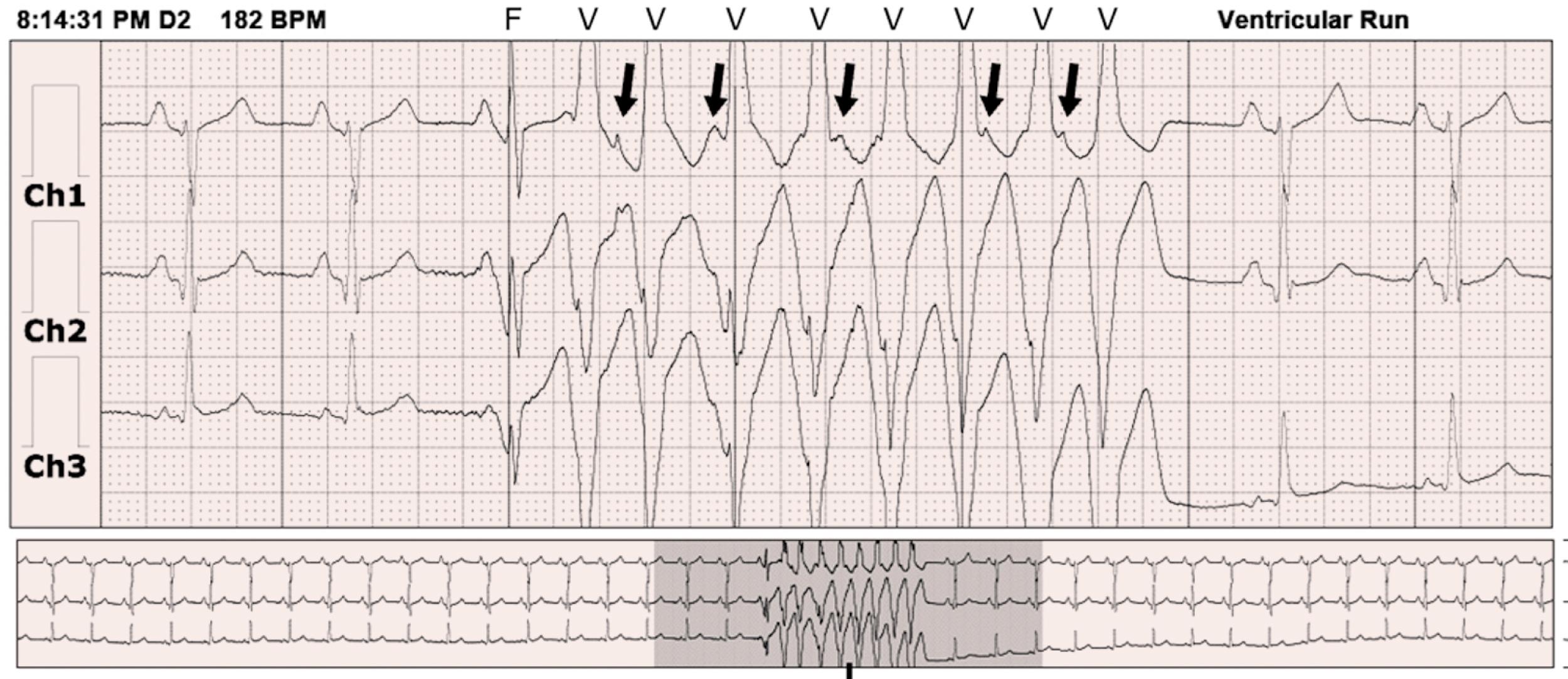
Significant rhythm disturbances are uncommon in healthy young persons. Sinus bradycardia with heart rates of 35 to 40 beats/min, sinus arrhythmia with pauses exceeding 3 seconds, sinoatrial exit block, type I (Wenckebach) second-degree AV block (often during sleep), wandering atrial pacemaker, junctional escape complexes, and PACs and PVCs can be observed and are not necessarily abnormal. Frequent and complex atrial and ventricular rhythm disturbances are less frequently observed, however, and type II second-degree AV conduction disturbances (see Chapter 68 ) are not recorded in normal patients. Elderly patients have a higher prevalence of arrhythmias, some of which may be responsible for neurologic symptoms ( Fig. 61.13 , see Chapter 90 ).
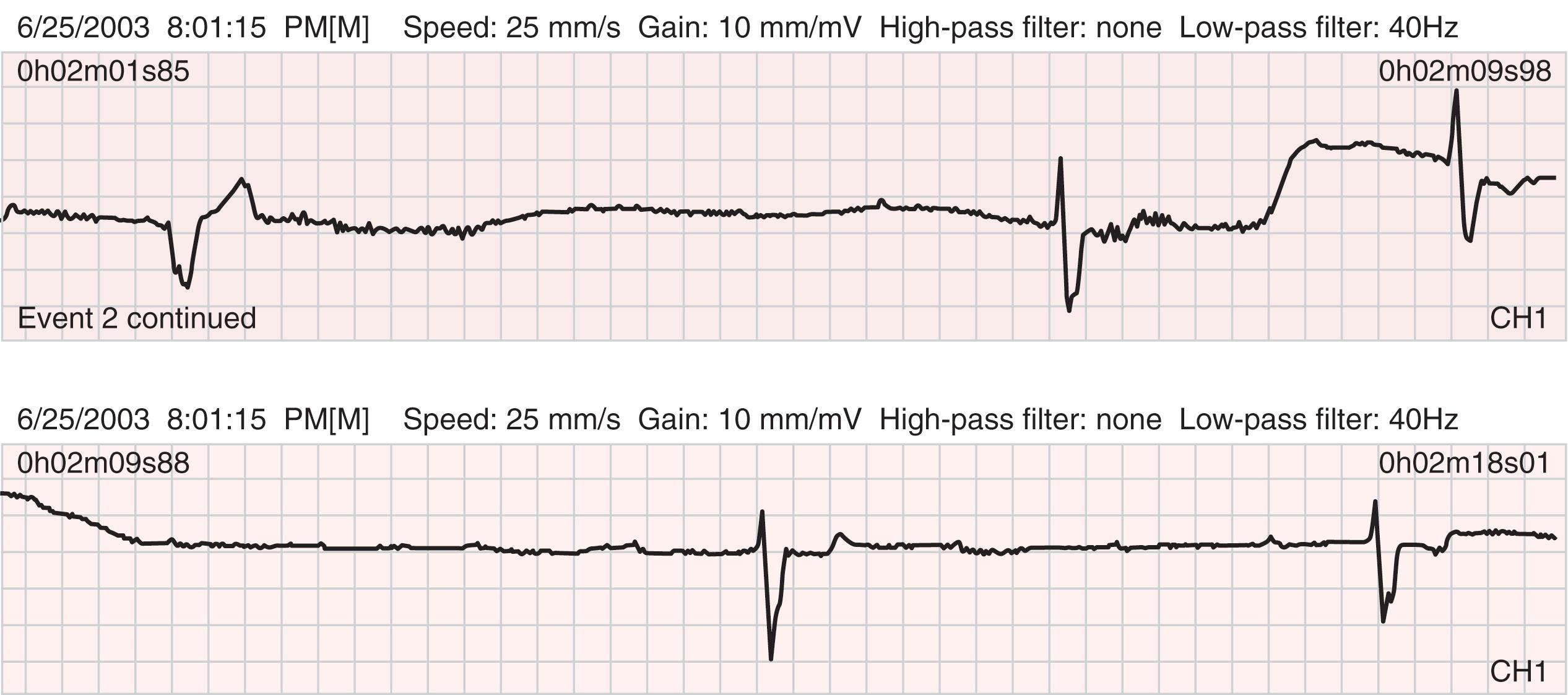
It is worth repeating that the long-term prognosis of even frequent and complex PVCs in asymptomatic healthy patients is very good, without an increased risk of mortality. However, frequent PVCs (>15% of the total) have been shown to produce a cardiomyopathy and heart failure in some people, which can be reversed following elimination of the PVCs. Most patients with ischemic heart disease, particularly after MI (see Chapter 37, Chapter 38, Chapter 39 ), exhibit PVCs when they are monitored for 24 hours. The frequency of PVCs progressively increases during the first several weeks and then decreases at about 6 months after infarction. Frequent and complex PVCs are associated with a two- to fivefold increased risk for cardiac or sudden death in patients after MI, but treating these PVCs may not improve the prognosis. Recent data indicate that ablation of PVCs after MI may improve previously depressed ventricular function.
Long-term recording of the ECG has also exposed potentially serious arrhythmias and complex ventricular ectopy in patients with left ventricular hypertrophy, as well as in those with hypertrophic, dilated, and ischemic cardiomyopathy; in those with mitral valve prolapse (see Chapter 76 ); in those with otherwise unexplained syncope ( Chapter 71 ) or transient vague cerebrovascular symptoms or stroke; and in those with conduction disturbances, sinus node dysfunction, bradycardia-tachycardia syndrome, WPW syndrome ( Chapter 65 ), and pacemaker malfunction ( Chapter 69 ). It has been shown that asymptomatic AF occurs far more often than symptomatic episodes in patients with AF.
Variations of Holter recording have been used for particular applications. Some monitoring systems are able to reconstruct a full 12-lead ECG from a seven-electrode recording system. This is especially useful in trying to document the ECG morphology of VT before an ablation procedure or a consistent morphology of PVCs that may arise from an ablatable focus of VT or VF. Most Holter recording and analysis systems can place a clearly recognizable deflection on the recording when a pacemaker stimulus is detected, facilitating diagnosis of potential pacemaker malfunction. On occasion, artifacts on the ECG can mimic bradycardias or tachycardias and lead to erroneous therapy. Finally, most systems can also provide heart rate variability and QT data (see below). Use of these systems for detection of myocardial ischemia (ST-segment analysis) has yielded mixed results for both specificity and sensitivity.
In many patients, the 24- or 48-hour snapshot provided by the Holter recording is insufficient to document the cause of the patient’s symptoms. Event recorders are indicated when symptoms occur less frequently (e.g., several episodes per month), and because the monitors are typically patient activated, and well-suited for correlating symptoms with rhythm disturbances. These devices come in various forms and are kept by the patient for an extended time, often up to 30 days. Event recorders can be continuous with auto-triggered or patient-activated recording ( eFig. 61.1 ). Discontinuous transtelephonic monitoring systems without looping memory require patient activation. When being worn by the patient, digital recordings can be made during symptomatic episodes and can be transmitted to a receiving station by telephone at the patient’s convenience (see Fig. 61.13 ). Some of these recorders store more than 30 seconds of the ECG before the patient activates the recording. These loop recorders record continuously, but only a small window of time is present in memory at any moment. When the patient presses the event button, the current window is frozen while the device continues recording for another 30 to 60 seconds, depending on how it is configured. Event recorders are highly effective in documenting infrequent events, but the quality of the recordings is more subject to motion artifact than with Holter monitors, and usually only one channel can be recorded. With most systems, the device automatically begins recording the rhythm when the heart rate increases or decreases outside preset parameters. Some systems incorporate cell phone technology that automatically notifies a central monitoring facility when certain conditions are met (e.g., extreme bradycardia or tachycardia). This can significantly shorten the time between occurrence and effective treatment of serious arrhythmias.
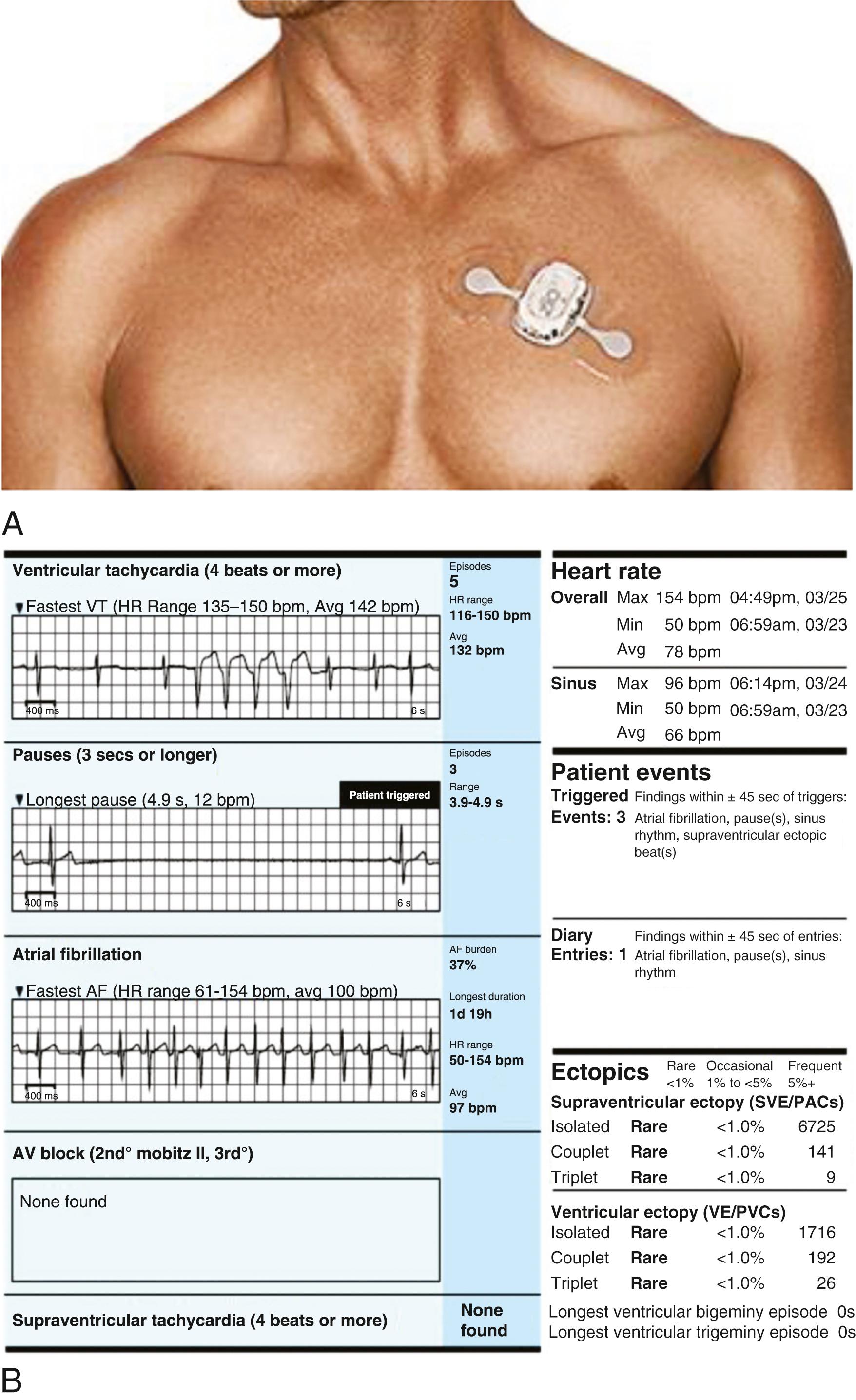
The use of wearables for cardiac monitoring has enabled detection of abnormalities in heart rate and rhythm on a much broader basis than physician-prescribed monitoring. Fitness bands and other wearables may have accelerometers that detect movement during exercise and other daily activities and correlate it with heart rate. There are a number of other devices that are accurate and easy to use, including smartphones and watches that use camera-based plethysmography to assess heart rate and rhythm. Algorithms have been developed to detect irregularity of the heart rate and notify a patient of “possible AF.” Although heart rate measurements tend to be fairly accurate, subsequent cardiac monitoring to confirm AF in patients alerted to a possible arrhythmia has shown confirmation of AF in less than half of the patients. Both iPhones and Android phones have applications for real-time ECG monitoring. They are useful for on-demand arrhythmia diagnosis and monitoring arrhythmia burden and are being used as a phenotyping platform in population studies ( eFig. 61.2 ). A small, lightweight device is available that has two electrodes on which the fingers of the left and right hands are placed to record a lead I ECG rhythm strip for 30 seconds. More recently, a third electrode has been added that allows for all six limb leads to be recorded. These rhythm strips can be uploaded to the cloud and downloaded to a physician’s office for subsequent verification of the rhythm. The latest versions of smartwatches can also record a single-lead rhythm strip by opening an app and placing the fingers of the hand opposite to the watch on the crown of the watch for 30 seconds.
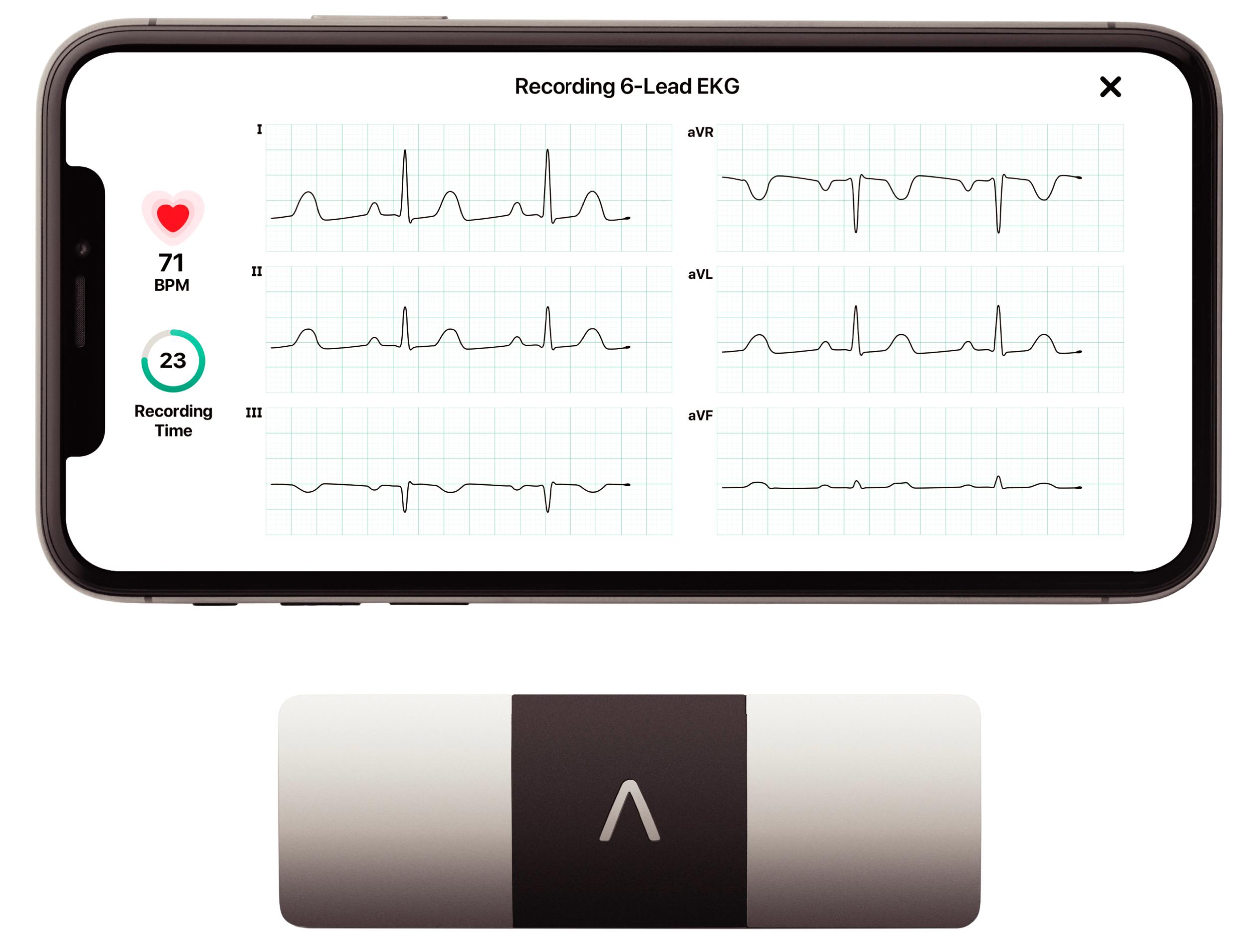
Most currently available pacemakers and ICDs can provide Holter-like data when premature beats or tachycardia episodes occur and can store electrograms of these events from the implanted leads ( Fig. 61.14 ). Dual-chamber devices can record atrial and ventricular high-rate episodes that can be correlated with the electrograms during such events (see Chapter 69 ). The device can then be interrogated and the electrograms printed for analysis. Many implanted device systems incorporate remote monitoring so that if symptoms develop, the information can be transmitted via the Internet to the physician’s office, thus enabling more prompt diagnosis and treatment than if the patient had to schedule an outpatient visit. For serious rhythm disturbances, such as sustained VT, this information can lead to timely changes in therapy; in other cases, such as incidentally discovered AF, therapeutic implications (e.g., initiation of anticoagulation) are less clear. Implantable monitors or insertable loop recorders (ILRs) are typically used for the evaluation of suspected serious arrhythmias that occur infrequently and cannot be provoked at diagnostic EPS. An ILR, a single-lead ECG monitoring device placed subcutaneously at approximately the level of the anterior second rib, monitors the cardiac rhythm for as long as 24 to 36 months. Both P waves and QRS complexes can be recorded by an ILR. These devices have both auto-triggered and patient-activated arrhythmia-recording capabilities ( eFig. 61.3 ). Use of such devices has been successful in recording tachyarrhythmias and, more often, bradyarrhythmias. The devices can be configured to store patient-activated episodes, automatically activated recordings (heart rate outside preset parameters), or a combination of these. ECG recordings can be sent to an analyzing center transtelephonically and then to physicians via the Internet. Interrogation of ILRs can also be performed remotely over a landline telephone. Technologic advances have resulted in further reduction in size and ease of implantation of ILRs, which has led to increased clinical deployment of these devices. ILRs have primarily been used in the evaluation of syncope, but their use is increasing in monitoring arrhythmia density, especially AF.

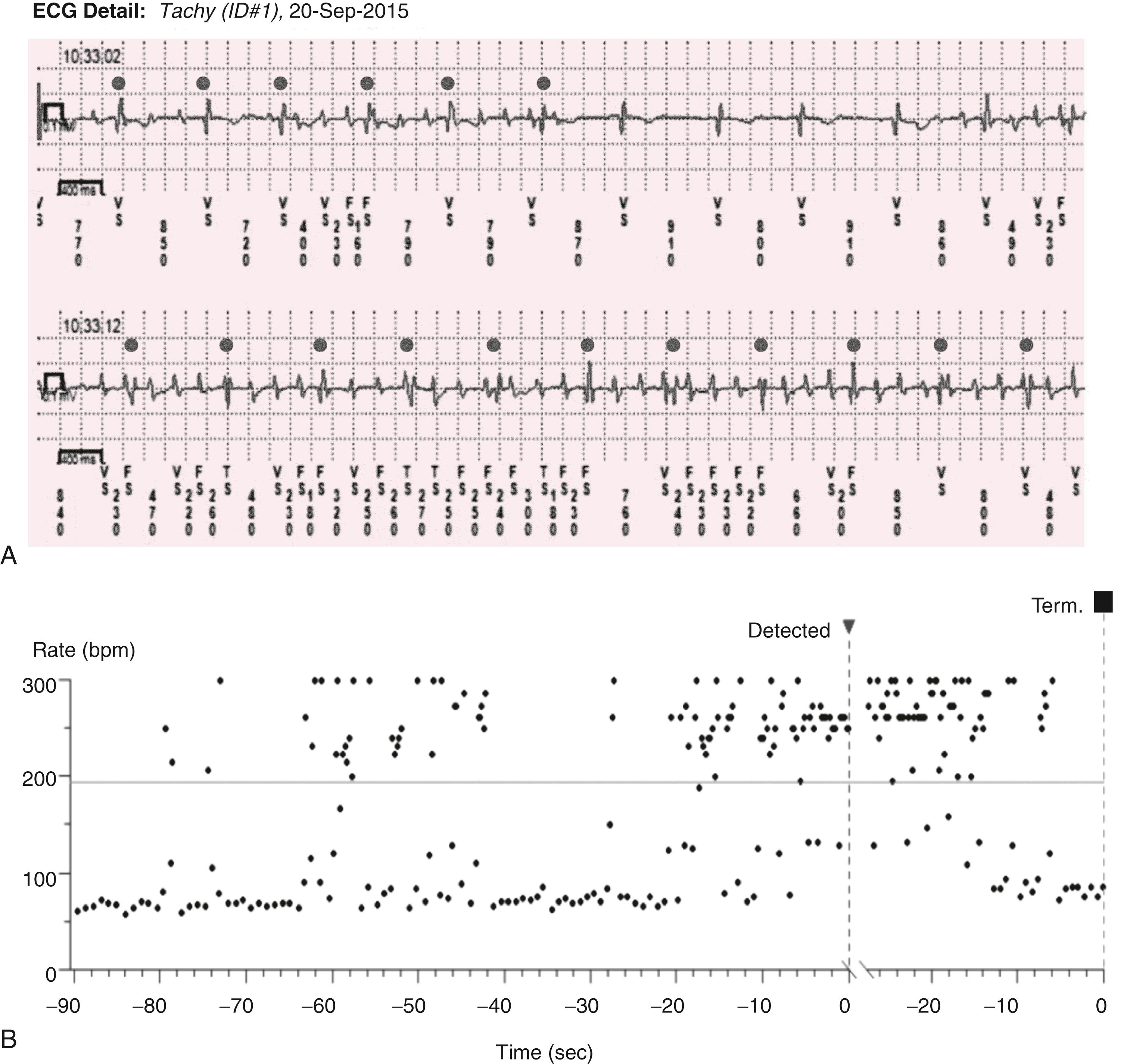
Various methods for evaluating components of the ECG and heart rate have been developed, mainly for the purpose of enhancing SCD risk stratification of patients. Few of them are used routinely today because of suboptimal sensitivity and specificity. Heart rate variability is used to evaluate vagal and sympathetic influences on the sinus node (inferring that the same activity is also occurring in the ventricles) and to identify patients at risk for a CV event or death. R-R variability predicts all-cause mortality after MI, as does left ventricular ejection fraction or nonsustained VT. , Similar results have been obtained in patients with dilated cardiomyopathy (see Chapter 50, Chapter 52 ).
Heart rate turbulence is a measure of reflex vagal control of the heart. Abnormal heart rate turbulence is a strong independent predictor of mortality in patients with CAD and dilated cardiomyopathy. QRS and QT dispersion and T wave abnormalities are a reflection of heterogeneity in refractoriness and conduction velocity, which is a hallmark of reentrant arrhythmias. Dispersion indices usually measure the maximum difference (shortest to longest) in the intervals of interest. Abnormally high QRS and QT dispersion have been correlated with risk for overall mortality and arrhythmic death in patients with various disorders. Signal-averaged electrocardiography and late potentials Signal averaging is a method that improves the signal-to-noise ratio when signals are recurrent and noise is random. Signal averaging can detect late ventricular potentials of 1 to 25 μV that correspond to the delayed and fragmented conduction in the ventricles recorded with direct mapping techniques in patients with VT ( eFig. 61.4 ). In specific situations, it can be helpful, as in a patient suspected of having ARVC. T wave alternans is beat-to-beat alternation in the amplitude or morphology of the ECG recording of ventricular repolarization, the ST segment, and the T wave. It has been found in conditions favoring the development of ventricular tachyarrhythmias, such as ischemia and LQTS, and in patients with ventricular arrhythmias. A positive T wave alternans test result has been associated with a worse arrhythmic prognosis in various disorders, including ischemic heart disease and nonischemic cardiomyopathy. Body surface mapping is used to provide a complete picture of the effects of currents from the heart on the body surface. The potential distributions are represented by contour lines of equal potential, and each distribution is displayed instant by instant throughout activation, recovery, or both. Electrocardiographic imaging is a method for recording cardiac electrical activity at the skin surface and spatially integrating it with imaging data (currently, cardiac CT scanning). Using complex mathematical processing of electrical data collected from 224 electrodes on the skin surface, this technique can plot or project atrial and ventricular electrical activity on an epicardial “shell” of the patient’s own heart and thereby follow the course of activation or repolarization during sinus rhythm or an arrhythmia ( eFig 61.5 ) .
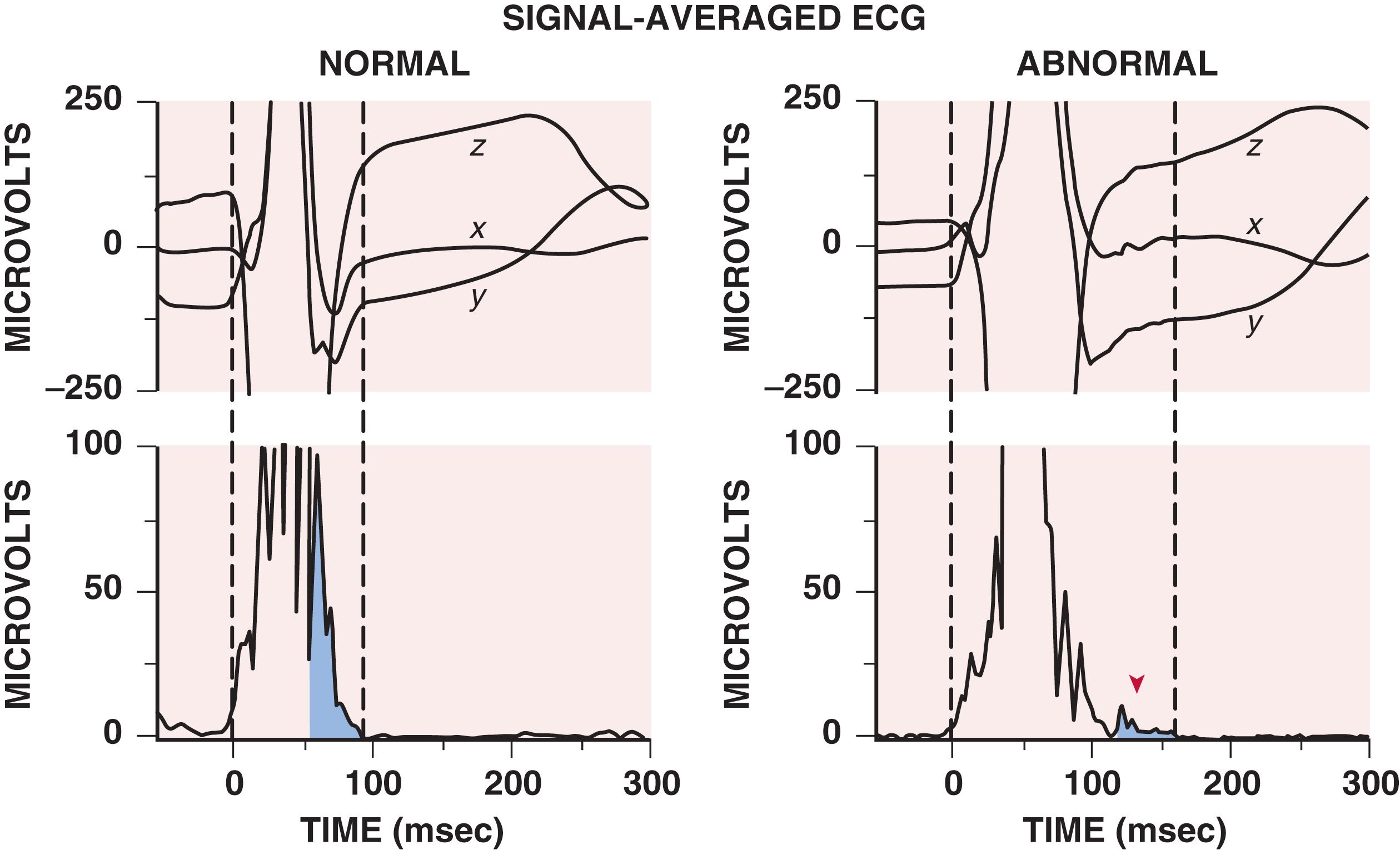
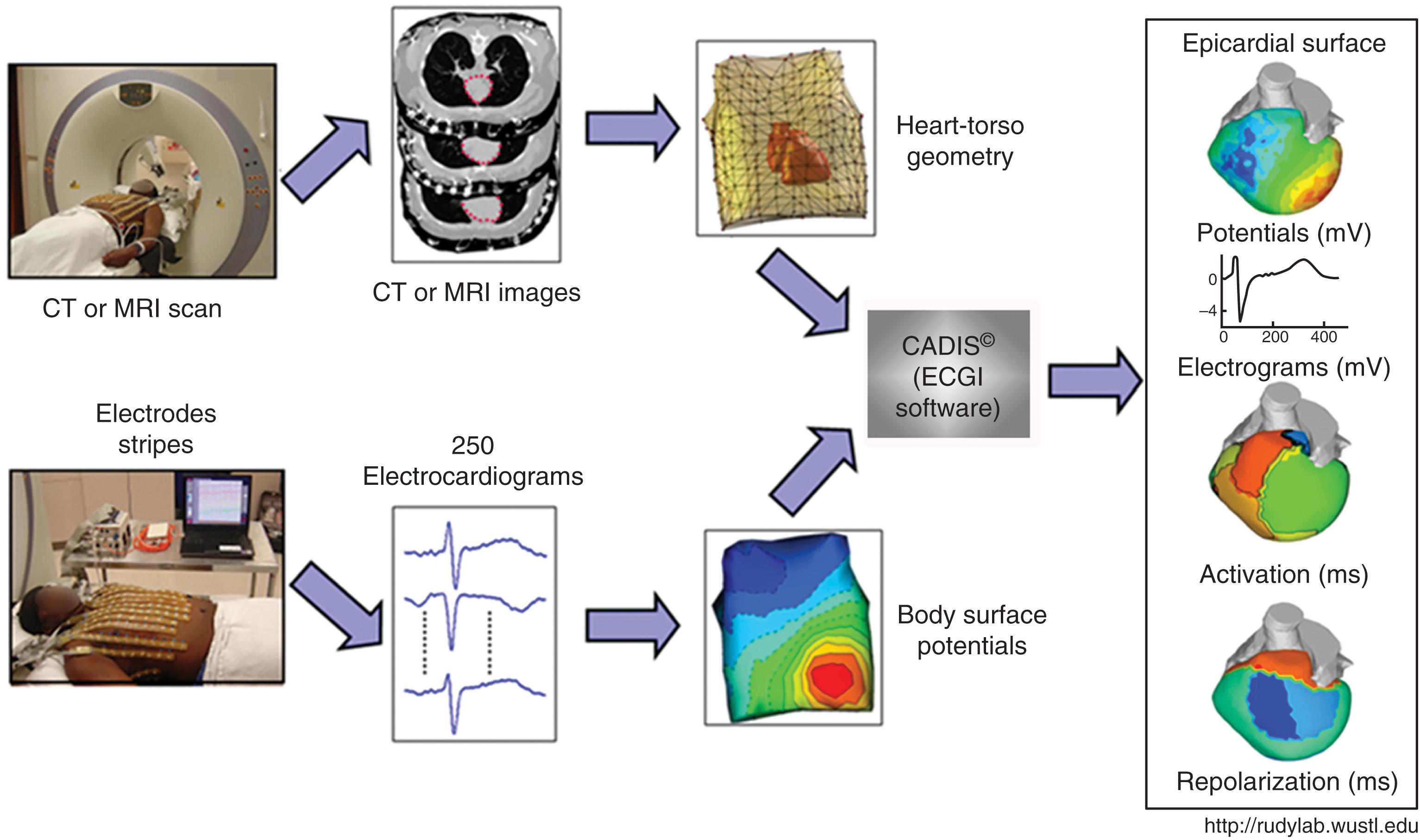
Tilt-table testing (TTT) is useful in the evaluation of patients without structural heart disease and recurrent syncope in whom there is a suspicion that exaggerated vagal tone producing cardioinhibitory and/or vasodepressor responses may play a causal role ( eFig. 61.6 ). In patients with structural heart disease, TTT may be indicated in those with syncope in whom other causes (e.g., asystole, tachyarrhythmias) have been excluded. TTT has been suggested as a useful tool in the diagnosis of and therapy for recurrent idiopathic vertigo, chronic fatigue syndrome, recurrent transient ischemic attacks, and repeated falls of unknown etiology in elderly patients without much evidence. Importantly, TTT is relatively contraindicated in the presence of severe CAD with proximal coronary stenoses, known severe cerebrovascular disease, severe mitral stenosis, and obstruction to left ventricular outflow (e.g., aortic stenosis).
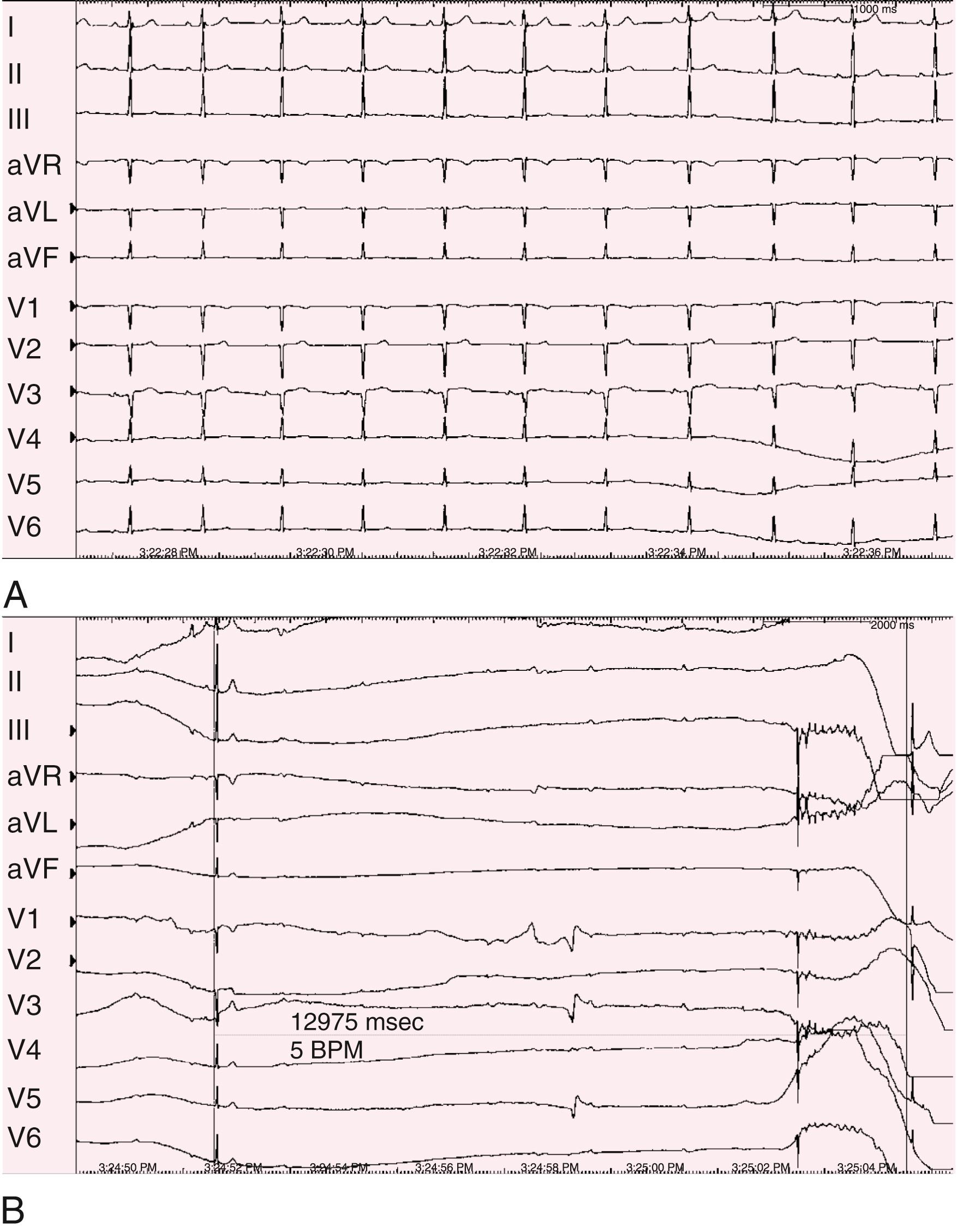
Patients are placed on a tilt table in the supine position and tilted upright to a maximum of 60 to 80 degrees for 20 to 45 minutes or longer if necessary. Isoproterenol, administered as a bolus or infusion, may provoke syncope in patients whose initial upright TTT result shows no abnormalities or, after a few minutes of tilt, may shorten the time needed to produce a positive response on the test. An initial intravenous isoproterenol dose of 1 μg/min can be increased in 0.5-μg/min steps until symptoms occur or a maximum of 4 μg/min is given. Isoproterenol induces a vasodepressor response in upright susceptible patients (decrease in heart rate and blood pressure along with near-syncope or syncope). Tilt-table test (TTT) results are positive in two-thirds to three-fourths of patients susceptible to neurally mediated syncope. They are reproducible in approximately 80% of patients but have a 10% to 15% false-positive response rate. A positive test result is more meaningful when it reproduces symptoms that have occurred spontaneously.
The physiologic response to TTT is incompletely understood; however, redistribution of blood volume and increased ventricular contractility occur consistently. Exaggerated activation of a central reflex in response to TTT produces a stereotypic response of an initial increase in heart rate, followed by drop in blood pressure and then a reduction in heart rate characteristic of neurally-mediated hypotension (see eFig. 61.6 ). Positive responses can be divided into cardioinhibitory, vasodepressor, and mixed categories ( eFig. 61.7 ). In patients with orthostatic hypotension and autonomic insufficiency, blood pressure will drop with only a minimal increase in heart rate. Patients with neurocardiogenic syncope or near syncope have been treated with beta blockers, disopyramide, theophylline, selective serotonin reuptake inhibitors, midodrine, fludrocortisone, salt loading, tilt-training, and thigh-high support stockings, alone or in combination. However, none of these treatments is reliably effective in most patients.
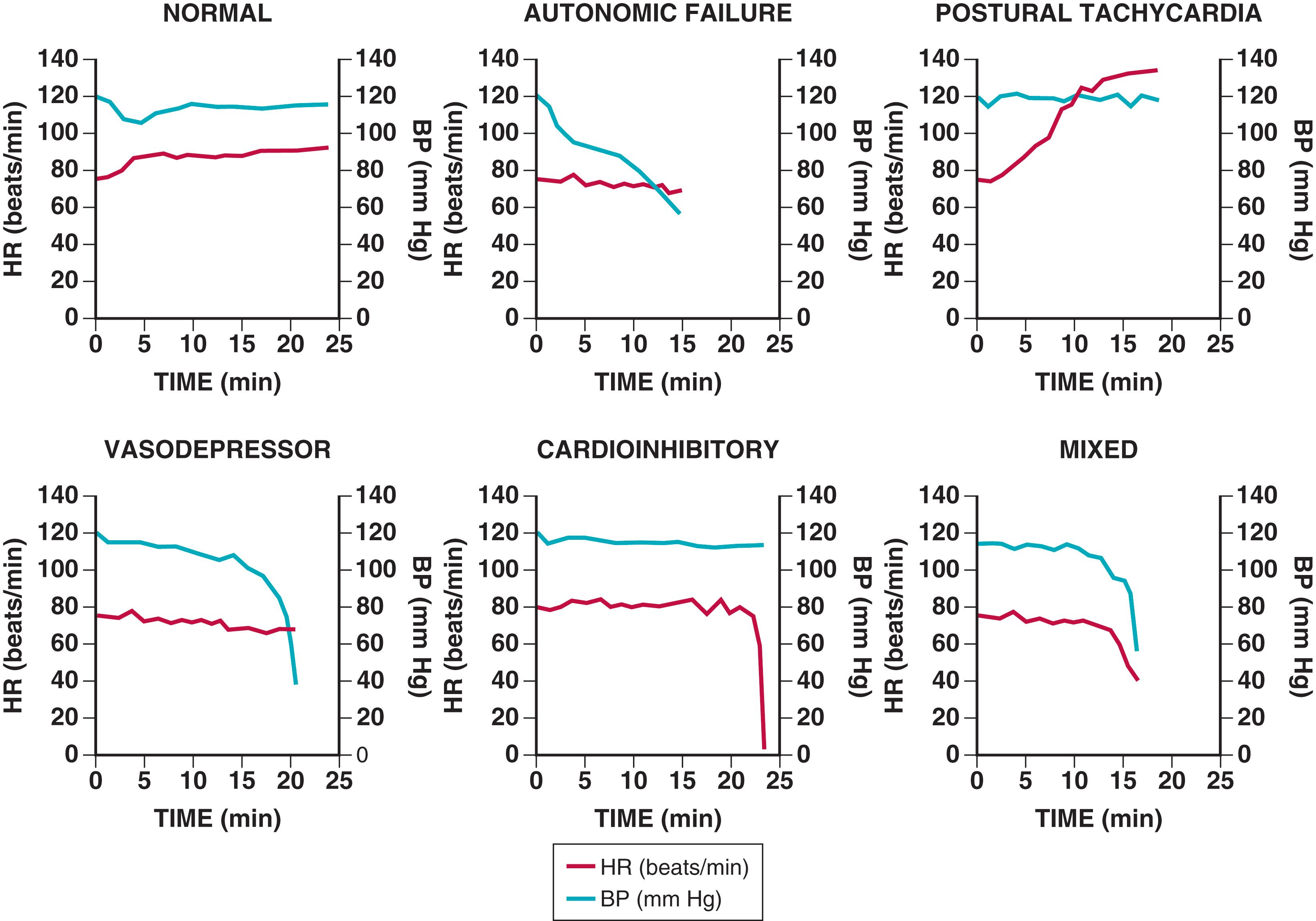
POTS is another aberrant variant of a neurocardiogenic reflex characterized by the inability to tolerate the upright posture and a dramatic increase (>30 beats/min) in heart rate (>120 beats/min) within 10 minutes of assuming an upright posture. A wide array of symptoms complicates the diagnosis of POTS, which is often confused with anxiety disorder, inappropriate sinus tachycardia, chronic fatigue syndrome, and fibromyalgia. , Data from an international registry suggest that endurance- and strength-training programs may be useful in managing POTS.
The EPS is central to the understanding and treatment of many cardiac arrhythmias. The indications for EPS fall into several broad categories: to define the mechanism of an arrhythmia, to deliver catheter-based ablative treatment, and to determine the etiology of symptoms that may be caused by an arrhythmia (e.g., syncope, palpitations). An invasive EPS involves introducing multipolar electrode catheters into the venous or arterial system and positioning them at various intracardiac sites or percutaneously into the pericardium to record or stimulate cardiac electrical activity. The positioning of these catheters is guided by complementary imaging modalities including fluoroscopy, intracardiac echocardiography (ICE) and electroanatomic mapping (EAM), often using MRI and CT to merge cardiac images with the EAM information. Guidelines for the use of electrophysiological procedures for diagnosis and therapeutic intervention are summarized in the Guidelines section of the online chapter and eTables 61G.4 and 61G.5 . This section addresses the requirement for maintenance of clinical competence in electrophysiological procedures including electrophysiological studies, catheter ablation, and cardiac rhythm device implantation and management.
The components of the EPS are baseline measurements of conduction under resting and stressed (rate or pharmacologic) conditions and maneuvers, both pacing and pharmacologic, to induce arrhythmias. Assessment of AV conduction at rest is done by positioning electrodes along the septal leaflet of the tricuspid valve and measuring the atrial-His interval (an estimate of AV nodal conduction time; normally, 60 to 125 milliseconds) and the His-ventricular (H-V) interval (a measure of infranodal conduction; normally, 35 to 55 milliseconds). The heart is stimulated from portions of the atria or ventricles and from the region of the His bundle, bundle branches, accessory pathways, and other structures. EP studies are performed diagnostically to provide information about the type of clinical rhythm disturbance and insight into its electrophysiologic mechanism. EPS are used therapeutically to terminate a tachycardia by electrical stimulation or electroshock, to evaluate the effects of therapy by determining whether a particular intervention modifies or prevents electrical induction of a tachycardia or whether an electrical device properly senses and terminates an induced tachyarrhythmia, and to ablate myocardium involved in the tachycardia and prevent further episodes. EPS have also been used prognostically to identify patients at risk for SCD. The study can be helpful in patients with AV block, intraventricular conduction disturbance, sinus node dysfunction, tachycardia, and unexplained syncope or palpitations (see Chapter 71 ).
An EPS is usually effective at initiating VT and SVT when these tachyarrhythmias have occurred spontaneously. Particularly for VT, programmed stimulation is used in a systematic attempt to induce the arrhythmia. Short bursts of fixed rate ventricular pacing (e.g., eight beats at 100 to 150 beats/min, corresponding to a pacing cycle length of 600 to 400 msec) are followed by single ventricular extrastimuli at varying coupling intervals, and eventually two or three extrastimuli are added. The ability to induce an arrhythmia using such stimulation techniques before an intervention (e.g., drug therapy or catheter or surgical ablation) allows one to assess the efficacy of treatment afterward by using the same stimulation techniques and demonstrating noninducibility. However, false-negative responses (not finding a particular electrical abnormality known to be present) and false-positive responses (induction of a nonclinical arrhythmia) may complicate interpretation of the results because many lack reproducibility. Altered autonomic tone in a supine patient undergoing EPS, hemodynamic or ischemic influences, changing anatomy (e.g., new infarction) after the study, day-to-day variability, and the use of an artificial trigger (electrical stimulation) to induce the arrhythmia are several of many factors that can explain the occasional disparity between test results and spontaneous occurrence of arrhythmia. Overall, the diagnostic validity and reproducibility of these studies are good, and they are safe when performed by skilled clinical electrophysiologists.
Become a Clinical Tree membership for Full access and enjoy Unlimited articles
If you are a member. Log in here